Real Estate Math Formulas and Free Hints to help Real Estate Agents pass the Real Estate Exam

A lot of people are afraid of the real estate math part. Unfortunately, real estate math concepts can be 10% or more of the real estate exam. Many people ignore the real estate math problems and hope that they’ll do well enough on the rest of the exam to pass. That’s certainly possible, but it doesn’t leave much room to miss other questions.
A better way is to master the math questions on the Real Estate Exam using our simple techniques.
This article starts the real estate career with a refresher on basic real estate math skills and some real estate math concepts before covering the skills needed to answer the most common real estate math questions on the Real Estate Exam.
The best part is that one simple formula can be used to answer most of the questions. Once you learn that formula, answering those questions will feel almost automatic.
Basic Math and Word Problems
Before jumping right into actual real estate math calculations, it's important to have a brief refresher on the most commonly used principles of basic math that are found on the real estate examination.
You probably won't see a question on your exam that directly tests your basic math abilities, but you will need to have these topics mastered to solve the questions that you will be asked. That's because most of the real estate math questions you'll see will require several steps to arrive at the solution. At least one of those steps will involve basic math.
There is special terminology used in each of these basic functions that sneaky exam writers love to use to trick you into getting a basic step wrong.
In fact, all that's reviewed in the addition, subtraction, multiplication, and division sections is terminology that will help you with word problems. After all, you won't need to review how to actually do these since you'll be able to use a calculator (check your state's requirements to see which kind you can bring or if they're provided).
Addition
Addend + Addend = Sum
The two (or more) numbers that are added together are called addends. The total, once added, is called the sum.
Addition Word Problem Keywords
These keywords indicate that you might be able to use addition to solve a word problem:
- add
- added
- additional
- all
- all together
- and
- both
- combined
- entire
- exceeds
- gain
- greater
- in addition to
- in all
- increased by
- more
- more than
- plus
- raise
- sum
- together
- total
Subtraction
Minuend – Subtrahend = Difference
The largest number that is subtracted from is called the minuend. The number that is subtracted from the minuend is known minuend is called the subtrahend. The result is known as the difference.
Subtraction Word Problem Keywords
These keywords indicate that you might be able to use subtraction to solve a word problem:
- change
- changed
- compare
- compared to
- decrease
- decreased by
- difference
- fewer
- fewer than
- higher
- how many more
- larger
- left
- less than
- longer
- lost
- minus
- reduced
- remain
- smaller
- subtract
- take away
Multiplication
Factor × Factor = Product
The numbers that are being multiplied are called factors. The answer is called the product.
Multiplication can be displayed in the following ways:

This next part is going to sound a bit advanced because mathematicians like to use confusing words, but hang in there.
When dealing with variables (think of solving for the variable x), multiplication can also be expressed by placing a coefficient in front of the variable, which means to multiply the variable by the coefficient.
In simple English pretend that you have a variable that we’ll call x. If we were to write 9x it would mean “9 times x.” See how that works? It’s pretty much the same as the third example above, but without the parenthesis. Getting back to that confusing terminology, the number 9 is the coefficient of the variable x.
Multiplication Word Problem Keywords
These keywords indicate that you might be able to use multiplication to solve a word problem:
- at
- each
- every
- groups of
- multiply
- per
- product
- rate
- sets of
- times
- total
- twice
Division
Dividend ÷ Divisor = Quotient
The number that is being divided is called the dividend. The number that you divide by is called the divisor. The answer is called the quotient.
Division can be displayed in the following ways:
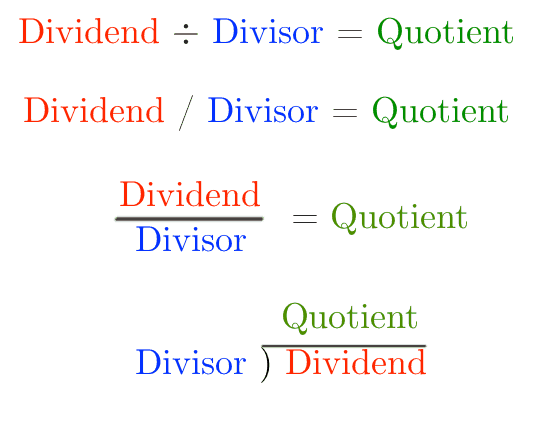
Division Word Problem Keywords
These keywords indicate that you might be able to use division to solve a word problem:
- average
- cut
- cut up
- divided
- divisor
- each
- equal parts
- evenly
- every
- half
- out of
- per
- quotient
- separate
- shared
- split
Order of Operations
If you do math problems in the wrong order you’ll get the wrong answer. That’s why there are rules for what to do first.
There’s a funny sounding word that can help us remember the rules. It’s the word PEMDAS. Let that word simmer in your memory as we look at the following problem.
If you need help letting it simmer you can try to remember the sentence Please Excuse My Dear Aunt Sally.
\( 7 - 2 \times 3 = \)
We’ll get two different answers if we solve this problem in a different order. If we started with \( 7 - 2 \) we’d get five and then multiply five times three to get fifteen.
\( 5 \times 3 = 15 \)
However, if we started with \( 2 \times 3 = \) then we’d get six and then subtract six from seven to get one.
\( 7 - 6 = 1 \)
We can both agree that there’s a difference between fifteen and one and they both can’t be the right answer. But one has to be, right?
That’s where PEMDAS comes in. The word PEMDAS helps us to understand the order used to solve a problem. The letters in the word stand for mathematical terms.
- P for Parentheses. If the problem has (parentheses) then solve what’s in them first.
- E for Exponents. If the problem has exponents2 then solve them next.
- M for Multiplication.
- D for Division. Complete all multiplication and division in the problem, working from left to right.
- A for Addition.
- S for Subtraction. Complete all addition and subtraction in the problem, working from left to right.
Multiplication and Division have the same priority so you’d complete all of the Multiplication and Division in the problem from left to right. You wouldn’t do all the Multiplication first and then do the Division.
The same goes for Addition and Subtraction. Complete all Addition and Subtraction from left to right. Don’t do Addition first and then Subtraction.
If you want to get really technical, we can group it this way:
- P
- E
- MD
- AS
But that doesn’t look as nice, right? Just remember that the operations that have opposites are on the same level. Multiplication and Division are opposites and so are Addition and Subtraction.
So how does this help us with the example problem we worked on above? It means that we were supposed to do the multiplication, not the subtraction, first. So that means the second answer (one) is the correct one.
Order of Operations Quiz
\( 5+3 \times 2= \)
- 11
- 16
- 10
- 8
Click for the Answer and Explanation
Answer: 11
Explanation: Using the order of operations we first multiply 3 times 2 to get 6 and then we add the 5 to the product to get 11.
Fractions
A fraction is a part of a whole. When you know this it’s easy to understand what’s meant when you see a fraction. That’s because fractions are written almost exactly like the definition. They are written as a part over a whole.
For example, the fraction \( \frac{1}{4} \) is written as a one over a four with a horizontal line separating them. There’s a one (the part) over a four (the whole).
\( \frac{part}{whole} \)
But what does that mean?
To better understand let’s look at a pie. In our example the whole (the bottom part) has four pieces so let’s break our pie up into four pieces. If you were to have all four pieces then you’d have the whole pie, right?

But we only want one part so our pie would look like this.
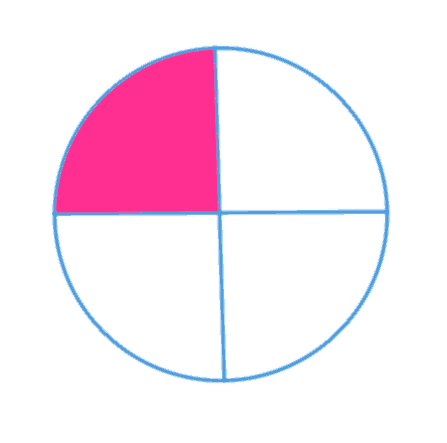
That is \( \frac{1}{4} \) of the pie. It’s one piece out of four possible.
So far, we’ve been using the terms “parts” and “whole” because those words match up with the definition of a fraction, but mathematicians don’t usually like to name things so they’re easy to remember.
The number on top, the one that we’ve been calling the “part” is called the “numerator.”
The number on the bottom, the one that we’ve been calling the “whole” is called the “denominator.”
\( \frac{numerator}{denominator} \)
If you ever forget which one goes on top and which one goes on the bottom think of “D” for “Down,” the Denominator goes down, which means that the numerator would go up.
Looking back at our pie above we can see that one is the numerator and four is the denominator.
Suppose we’re starving and we want two parts of the pie.
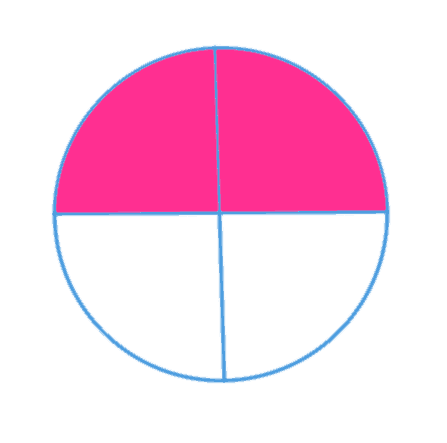
Two would become the numerator, and the denominator would stay the same because we still have four total parts that make up the whole.
But something interesting just happened. We can easily see that the pie is half gone.
So just by observing, we can see that \( \frac{2}{4} \) equals \( \frac{1}{2} \), but let’s look at the math behind it.
Whenever we have a fraction we may be able to simplify it. We do this by finding a common factor—something that each number can be divided by.
In the case of \( \frac{2}{4} \) both the numerator (two) and denominator (four) can be divided by two. How did we know that? It’s because we know our times tables. If you don’t know yours it’s a good idea to review them before your exam. Yes, you can use a calculator but finding factors and simplifying equations is a lot easier if you know them.
So, let’s go ahead and divide both the numerator and denominator by two.
\( 2 \div 2 = 1 \)
\( 4 \div 2 = 2 \)
Two divided by two equals one and four divided two equals two so the fraction \( \frac{2}{4} \) simplifies to \( \frac{1}{2} \).
Note that the reverse is also true. If you wanted to know what half of eight pieces of pie was you’d multiply the denominator (two) by four to get eight total pieces.
\( 4 \times 2 = 8 \)
How did we know to multiply two by four to get eight? It’s those times tables again. I’m starting with a two and I want to get eight. I know that two times four is eight so I use four as my factor.
Since you multiplied the denominator by four you’d also multiply the numerator (one) by four to get four pieces.
\( 1 \times 4 = 4 \)
So four pieces out of eight (\( \frac{4}{8} \)) would be half of an eight piece pie.
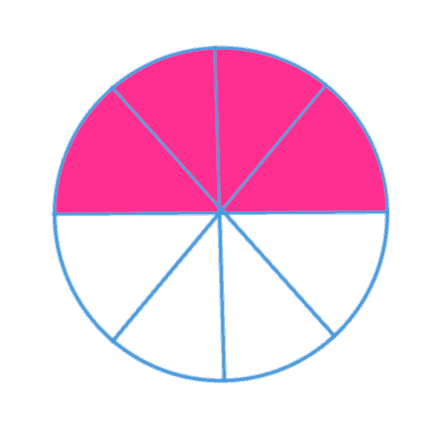
Now suppose we had \( \frac{7}{8} \) of our pie.
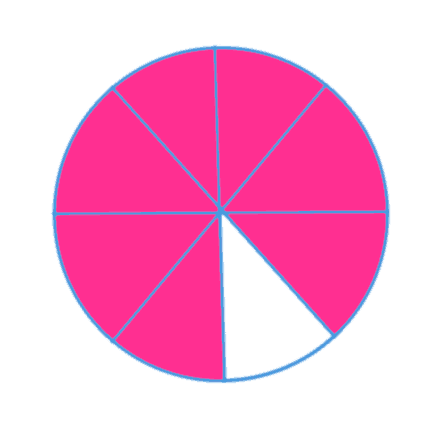
Could we simplify? We can’t because there isn’t a common factor between seven and eight.
What if we had \( \frac{8}{8} \) of our pie?
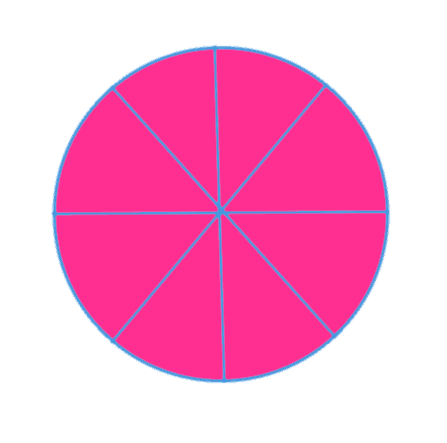
We can easily see that this is the whole pie, but this also gives us the opportunity to learn something else. Fractions are really division.
If you don’t believe me just divide eight by eight. What did you get? You got one, right? You got one whole pie.
\( 8 \div 8 = 1 \)
This also works if we simplified the fraction. \( \frac{8}{8} \) would simplify to \( \frac{1}{1} \) and one divided by one is one.
\( 1 \div 1 = 1 \)
If you divided a fraction where the numerator and denominator were not the same, you’d get a decimal number, but that’s a topic for later.
Adding and Subtracting Fractions
Suppose my friend cut up a cherry pie into four equal pieces. My friend then put one piece on my plate. It would look something like this.
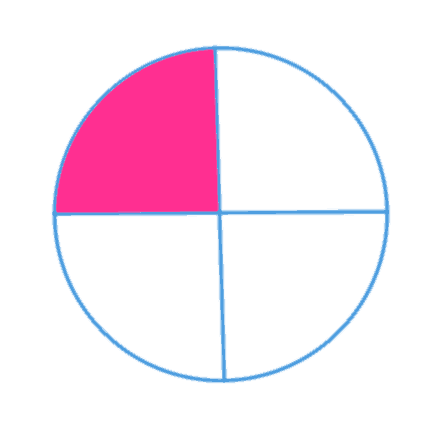
I mentioned to my friend that I love cherry pie and haven’t had it in years. So my friend immediately put another piece on my plate, which now looked something like this.
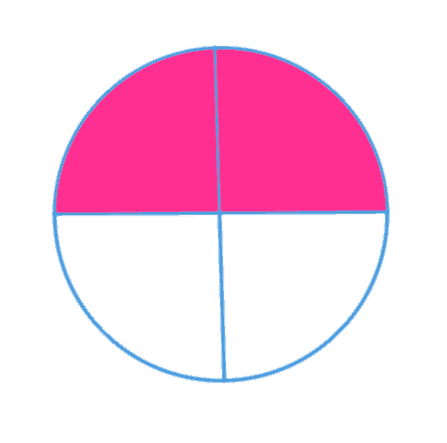
Let's think about what just happened in math terms. After my friend placed the first piece on my plate I had \( \frac{1}{4} \) of the pie on my plate. After the second piece was added I had \( \frac{2}{4} \) of the pie on my plate.
\( \frac{1}{4} + \frac{1}{4} = \frac{2}{4} \)
That was a pretty basic and easy example, but it's best to start simple. And we already know that \( \frac{2}{4}\) simplifies to \(\frac{1}{2} \).
In fact adding and subtracting fractions is pretty simple. All you have to do is add or subtract the numerators. But there is one catch: the denominators have to be the same. Remember the difference between the numerator and denominator? Think d for down. The denominator goes down.
\( \frac{numerator}{denominator} \)
In our example, we were talking about pieces of the same pie so we already had a common denominator (one that's the same). It was four because there were four pieces.
But what happens when we want to add a fraction that doesn't have a common denominator? We have to make the problems have a common denominator ourselves.
Remember how we figured out in a previous topic that \( \frac{1}{2} \) of a pie was the same as \( \frac{4}{8} \) of a pie? If you don't you should probably go back and review again.
But we figured out they were the same because we multiplied both the numerator and denominator by the same number (which was four in that example). That means we are able to multiply the numerators and denominators of each fraction by the same number to get a new denominator and an equal fraction.
Let's try the following problem.
\( \frac{1}{4} + \frac{3}{8} = \)
This one's pretty simple. The denominators are four and eight and we know that \( 4 \times 2 = 8 \) so let's multiply both the numerator and denominator of \( \frac{1}{4} \) by two.
\( \frac{1 \times 2}{4 \times 2} + \frac{3}{8} = \)
It might look a bit confusing when it's part of a larger problem, but all we did was change the first fraction so it has a denominator of eight, so it matches the second fraction.
After doing the multiplication, the new problem will look like this.
\( \frac{2}{8} + \frac{3}{8} = \)
Let's review before moving on. Since we wanted an eight and know that we'd need to multiply the current denominator of four by two to get eight we go ahead and do that. But if we multiply the denominator we need to multiply the numerator by the same number so we did that too.
Since the denominators are now the same we can simply add the numerators to solve the problem.
\( \frac{2}{8} + \frac{3}{8} = \frac{5}{8} \)
But what happens when we look at the denominators and can't figure out a common denominator? We can simply multiply both denominators to find one.
\( \frac{6}{8} + \frac{4}{9} = \)
In this example we'd multiply eight by nine to find the common denominator of 72.
\( 8 \times 9 = 72 \)
So we know that our common denominator is 72, but what do we do with the numerators? We have to multiply those too.
\( \frac{6\times 9}{8 \times 9} + \frac{4 \times 8}{9 \times 8} = \)
Notice that we're multiplying the numerator and denominator of each fraction by the denominator of the other fraction. When we complete the multiplication, our problem will become much more solvable.
\( \frac{54}{72} + \frac{32}{72} = \)
Now, we add the numerators and keep the denominators the same.
\( \frac{54}{72} + \frac{32}{72} = \frac{86}{72} \)
It's common practice to simplify fractions by dividing the numerator and denominator by a common factor. I can see clearly that two is a common factor because these are both even numbers. So, let's divide both the numerator and denominator by two.
\( \frac{86 \div 2}{72 \div 2} = \frac{43}{36} \)
Also notice that the numerator is greater than the denominator. That's what's called an improper fraction. An improper fraction can be converted into a mixed number. What's a mixed number? Let's make one to see.
The first step is to see how many times the denominator will fit in the numerator. In this example I know that 36 fits into 43 one time. How do I know that? Because if I tried more times I'd go over. The point is to see how many times the numerator fits and get as close as you can without going over. It's sort of like that game show.
The next step is to see how much I left in the numerator. Since 36 only went in one time I can simply subtract 36 from 43, but that wouldn't necessarily work out in problems where it goes in more than once. So let's do it that way even though we don't need to just to learn something.
\( 43-(36 \times 1) = 43-36 = 7 \)
I multiplied 36 times one because it went in one time. So now, if you have a problem that goes in more times, you'll know how to figure it out. I completed solving using PEMDAS. Remember PEMDAS?
The one time that 36 went into 43 becomes a big number one, and the seven remains part of the original fraction.
\( \frac{43}{36} = 1\frac{7}{36} \)
The improper fraction \( \frac{43}{36} \) converts into the mixed number \( 1\frac{7}{36} \).
You might have to add or subtract mixed numbers. Before you do anything else you must convert it into an improper fraction. We do this by doing the opposite of what we just did.
Suppose we wanted to convert the following mixed number into an improper fraction.
\( 4\frac{3}{8} \)
While keeping the denominator we multiply the whole number (four) by the denominator (eight) and add it to the numerator (three).
\( \frac{4 \times 8 + 3}{8} = \frac{35}{8} \)
If we were adding or subtracting mixed numbers, we could go on to finding a common denominator, if needed.
We've come a long way and I haven't taught how to subtract yet. That's because it's exactly the same as addition, except you subtract after you have common denominators instead of adding. Here's a summary of the entire process.
- Convert any mixed numbers into improper fractions.
- Find a common denominator if there isn't one already.
- Add or subtract the numerators while keeping the denominator the same.
- Simplify
Fraction Formulas
The following formulas summarize what was explained above using variables.
\( \frac{a}{b} + \frac{c}{b} = \frac{a+c}{b} \)
\( \frac{a}{b} + \frac{c}{d} = \frac{a \times d + b \times c}{b \times d} \)
\( \frac{a}{b} - \frac{c}{b} = \frac{a-c}{b} \)
\( \frac{a}{b} - \frac{c}{d} = \frac{a \times d - b \times c}{b \times d} \)
Adding and Subtracting Fractions Quiz
\( \frac{1}{2}+\frac{1}{4}= \)
- \( \frac{3}{4} \)
- \( \frac{2}{2} \)
- \( \frac{2}{4} \)
- \( \frac{3}{2} \)
Click for the Answer and Explanation
Answer: \( \frac{3}{4} \)
Explanation: We use the common denominator of 4 and solve \( \frac{2}{4}+\frac{1}{4}=\frac{3}{4} \)
\( \frac{2}{3}-\frac{1}{3}= \)
- 2
- \( \frac{1}{3} \)
- \( \frac{2}{3} \)
- 0
Click for the Answer and Explanation
Answer: \( \frac{1}{3} \)
Explanation: There is already a common denominator, so we subtract the numerator and keep the denominator the same. \( \frac{2}{3}-\frac{1}{3}=\frac{1}{3} \)
Multiplying and Dividing Fractions
After reviewing how to add and subtract fractions you might be worried about all of the steps required to multiply and divide them. Don't worry. It's actually much easier. You don't need to find a common denominator.
To multiply fractions you simply multiply the numerator by the numerator and the denominator by the denominator.
\( \frac{3}{4} \times \frac{2}{5} = \frac{3 \times 2}{4 \times 5}= \frac{6}{10} = \frac{3}{5} \)
Let's break that down a bit. First we rewrote \( \frac{3}{4} \times \frac{2}{5} \) as \( \frac{3 \times 2}{4 \times 5} \) to clearly see that we're simply multiplying the numerators together and the denominators together.
We then solved the multiplication to reach the answer of \( \frac{6}{10} \), which I then simplified to \( \frac{3}{5}\) by dividing both the numerator and denominator by two. I didn't show it above, but the equation would be \( \frac{6 \div 2}{10 \div 2}=\frac{3}{5} \).
Dividing fractions is almost exactly the same as multiplying them. I take that back. Dividing fractions is exactly the same as multiplying them. You just have to do one thing first.
\( \frac{5}{8} \div \frac{1}{3} \)
To divide this fraction we simply flip the divisor (the \( \frac{1}{3} \) and then multiply. To flip the fraction you turn it upside down so \( \frac{1}{3} \) becomes \( \frac{3}{1} \). Our division problem has now become a multiplication problem and we already know how to solve those.
\( \frac{5}{8} \times \frac{3}{1}=\frac{5 \times 3}{8 \times 1}=\frac{15}{8}=1\frac{7}{8} \)
I won't explain all the steps here because you should be familiar with them already. If not you should probably go back and re-review.
Fraction Formulas
The following formulas summarize what was explained above using variables.
\( \frac{a}{b} \times \frac{c}{d} = \frac{a \times c}{b \times d} \)
\( \frac{a}{b} \div \frac{c}{d} = \frac{a}{b} \times \frac{d}{c} = \frac{a \times d}{b \times c} \)
Multiplying and Dividing Fractions Quiz
\( \frac{1}{3} \times \frac{2}{5}= \)
- \( \frac{2}{15} \)
- \( \frac{1}{15} \)
- \( \frac{2}{5} \)
- \( \frac{2}{3} \)
Click for the Answer and Explanation
Answer: \( \frac{2}{15} \)
Explanation: To multiply fractions, we multiply the numerator by the numerator and the denominator by the denominator. \( \frac{1}{3} \times \frac{2}{5}=\frac{2}{15} \)
\( \frac{5}{6} \div \frac{8}{9}= \)
- \( \frac{45}{48} \)
- \( \frac{5}{8} \)
- \( \frac{9}{6} \)
- \( \frac{4}{3} \)
Click for the Answer and Explanation
Answer: \( \frac{45}{48} \)
Explanation: To divide fractions, we flip the divisor and then multiply the numerator by the numerator and the denominator by the denominator. \( \frac{5}{6} \times \frac{9}{8}=\frac{45}{48} \)
Decimals
A decimal is really a fraction, but it's based on a power of ten. If that sounds confusing rest assured that it won't be once you read this section.
We'll review what decimals are and then move on to reviewing how to round them. We won't review the basic operations (addition, subtraction, multiplication, and division) of decimals because you can do those on your calculator.
Okay, it's time for something obvious. A decimal number is a number that's written with a decimal point. Profound, right?
A decimal number has a whole number part and a decimal part. The decimal part represents a partial number similar to a fraction. The part to the left of the fraction is the whole number part and the part to the right of the fraction is the decimal part.
Let's look at a big decimal number.
\( 3,082,196.47305 \)
Wow, impressive, right?
Seriously, though, the most important thing to remember about decimals is that they're really just another way of expressing a fraction.
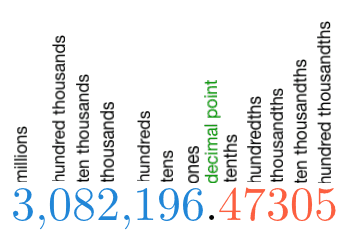
We're interested in the red numbers. Those are the decimal numbers. They're after the decimal point.
I'm getting a bit ahead of myself here since we'll officially be reviewing how to convert decimals to fractions in a later section but look at the red four. It's in the tenths place. You'd say "four tenths" if you wanted to pronounce that number.
You can also write "four tenths" as the fraction \( \frac{4}{10} \), which (probably not coincidentally) you'd also pronounce as "four tenths."
And the entire decimal portion would be pronounced "forty-seven thousand three hundred and five hundred thousandths," which could also be written as \( \frac{47,305}{100,000} \).
Decimals Quiz
What number is in the thousandths place?
\( 1,234.5678 \)
- 1
- 7
- 6
- 8
Click for the Answer and Explanation
Answer: 7
Feedback: The number 7 is in the thousandths place.
Rounding Numbers and Decimals
To round a number just means to approximate it to the nearest easier, more interesting, or more appropriate number. We might round numbers when we're shopping. If something costs $5.90 we might think of it as $6 to make adding it up in our head with the rest of the items we want to buy easier.
Rounding makes solving more difficult problems easier if we're not worried about accuracy. Unfortunately accuracy is very important in a serious real estate transaction or investment transaction because money is involved, but there are some cases where rounding can come in handy.
As an example, we might round to cents if we're dealing with an annual interest rate, on our mortgage payments principal because we can't pay in fractions of a cent.
Suppose a client wanted to know how much paint would be needed to cover a room. You might round the measurements to make calculating the area in your head easier.
So how do you round? The magic number is five. Anything less than five rounds down and anything five or greater rounds up. That's seriously all you need to know.
Let's look at the number 36. Suppose you wanted to round this to the nearest ten. That means it's either going to round up to 40 or round down to 30.
The number we're interested in looking at is the 6. That's the number right next to the place value that we're rounding to (tens) so it determines how the number is rounded.
Remember our magic number five? Six is greater than five so we round up. 36 rounds up to 40.
Let's look at a different number. Let's round 6,842 to the hundreds place. That means our rounded number will either be 6,800 or 6,900.
The number just to the right of the number we're rounding is four. Four is less than the magic number five so we round down. The answer is 6,800.
Decimals are rounded the same as whole numbers. The most difficult part is remembering what all the place values are called. To help here's the graphic from the last topic.
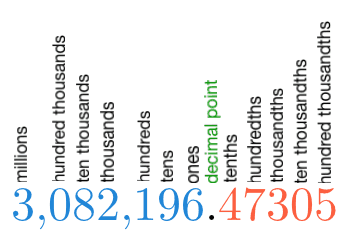
Suppose you were asked to round 704.235 to the hundredths place.
First, don't get confused and think you're rounding to the hundreds place. There's a "ths" at the end. If a place value ends in a "ths" you know that you are dealing with the decimal portion.
The number that is in the hundredths place of the number 704.235 is the number three. So that means our number is going to round up to 704.240 or round down to 704.230.
The number right next to the number we're rounding is a five. That's our magic number. Remember that we round up if the number is greater than or equal to five. So the rounded number is 704.240.
But we can drop the zero since trailing zeros in the decimal portion just mean nothing's in those places. Not writing anything in those places means the same thing and looks much cleaner. So our number becomes 704.24.
Rounding Numbers and Decimals Quiz
Round to the nearest hundredth.
\( 56.4623 \)
- 56.4
- 56.4623
- 100
- 56.46
Click for the Answer and Explanation
Answer: 56.46
Explanation: 56.4623 rounded to the nearest hundredth is 56.46. We look at the digit in the thousandths place (2) to decide to round up or down. Since 2 is below 5 we round down and the 6 does not change.
Round to the nearest tenth.
\( 42.764 \)
- 42.7
- 42.76
- 42.8
- 42.764
Click for the Answer and Explanation
Answer: 42.8
Explanation: 42.764 rounded to the nearest tenth is 42.8. We look at the number in the hundredths place (the 6) and see that it is greater than or equal to five so we round the digit in the tenths place up to 8.
Percents and Converting Percents, Decimals, and Fractions
Many math questions on the Real Estate License Exam have to deal with percentages. In this section we'll review what a percentage is and how to convert between decimals, fractions, and percentages.
A percentage is simply a fraction, but the denominator is always 100. So 75% means \( \frac{75}{100} \).
But even though percentages are based on a total of 100, most totals aren't exactly 100. You might need a 70% or a 75% to pass your Real Estate License Exam, but there might not be 100 questions. How can you calculate a percent based on a total that is not equal to 100?
Hint: You use the conversions in the following sections.
Convert Fractions to Decimals
Suppose there are 85 questions on your Real Estate License Exam, you need a 75% to pass and you get 64 of them right? Did you pass?
You got 64 out of 85 correct. Any time you hear the words "out of" you're hearing about a fraction. That means that we can write "64 out of 85" like this: \( \frac{64}{85} \).
I've hinted about it in previous sections, but fractions are really division. \( \frac{64}{85} \) is the same as \( 64 \div 85 \). If you put that into your calculator you'll get 0.7529411765. We just converted a fraction into a decimal! All you have to do is divide.
Convert Fractions to Decimals Quiz
Convert the following fraction to a decimal.
\( \frac{5}{8} \)
- 0.85
- 0.625
- 0.58
- 62.5%
Click for the Answer and Explanation
Answer: 0.625
Explanation: \( \frac{5}{8}=5 \div 8 = 0.625 \)
Convert Decimals to Percents
To convert that decimal to a percentage we just need to round to the nearest hundredth and then multiply by 100.
You won't always have to round and in many cases it may be a bad idea, but test scores are typically rounded.
0.7529411765 rounded to the nearest hundredth would be 0.75. We then multiply 0.75 by 100 to get the percent.
\( 0.75 \times 100 = 75 \)
64 out of 85 correct is a 75%. Congratulations, you passed, but barely. Keep studying to be sure to get a higher score on the real test!
For some problems rounding might not be necessary. You'll be able to tell by the language in the problem and the answer choices given.
If the problem says to round to a certain number, then do it. If it doesn't say to round so you don't, but you do not see your answer in the list of choices try rounding to see if your answer is there.
Test writers can be sneaky, but they usually won't give you a problem where rounding will be necessary unless they tell you to round.
Convert Decimals to Percents Quiz
Convert the following decimal to a percent. Do not round.
\( .645 \)
- 645%
- 56%
- 6.45%
- 64.5%
Click for the Answer and Explanation
Answer: 64.5%
Explanation: \( 0.645 = 64.5\% \) The problem specifically said not to round so 65% is incorrect.
Convert Decimals to Fractions
To convert a decimal to a fraction we have to do the reverse. Suppose we have that decimal 0.85.
We already learned that this means 85 hundredths. That means we can write it like this: \( \frac{85}{100} \). Hey, that's a fraction!
But since mathematicians like to simplify fractions, let's simplify that one. I can see that five is a factor of both the numerator and denominator.
\( \frac{85 \div 5}{100 \div 5}=\frac{17}{20} \)
Convert Decimals to Fractions Quiz
Convert the following decimal to a fraction.
\( 0.55 \)
- 55%
- \( \frac{11}{20} \)
- \( \frac{100}{55} \)
- \( \frac{55}{1000} \)
Click for the Answer and Explanation
Answer: \( \frac{11}{20} \)
Explanation: \( 0.55=\frac{55}{100}=\frac{11}{20} \)
Convert Percents to Decimals
To convert a percent to a decimal simply divide by 100. Let's turn 54% into a decimal.
\( 54 \div 100 = 0.54 \)
You can solve that on your calculator or just move the decimal point two places to the left.
Convert Percents to Decimals Quiz
Convert the following percent to a decimal.
\( 57\% \)
- 0.75
- \( \frac{57}{100} \)
- 0.57
- 0.7142857143
Click for the Answer and Explanation
Answer: 0.57
Explanation: 57% = 0.57
Geometry
There is a lot of geometry in real estate transactions. Don't stress out about it, though, because the geometry you need to know is pretty basic. All you need to know is a few simple formulas to calculate perimeter, area, and volume along with some more specific real estate calculations like square footage and acreage.
How Much Geometry Should You Know?
Unfortunately there are a lot of formulas in Geometry. Even worse, you might be asked a question on your real estate exam that involves any of them.
The good news, though, is that you’ll probably only see one question that involves having to use one of these formulas. And if you’re really lucky you might not see any.
So how much geometry should you know? The answer is that it depends.
If you have the time, you’ll maximize your chance of success if you memorize all of these math formulas here.
But if you don’t have the time to memorize real estate math formulas so it won’t hurt your score too bad.
The best news is that you’ll probably memorize enough simply going though the following sections and completing the quizzes.
Perimeter
The perimeter is the distance around a shape. If there was a fence around a lot, we could find the perimeter by counting our steps while walking around the lot.
Although that would technically be the perimeter, people's step sizes can vary so standard units of measurement like feet or yards are used.
Perimeter of a Square
\( perimeter=4 \times length \)
By definition a square has four equal sides. That means that you only need to know one side to figure out the perimeter.
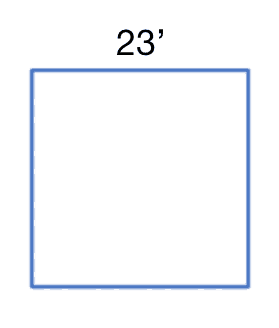
To find the perimeter of the square above we'd simply add up the lengths of all of the sides, which would be \( 23+23+23+23=92 \). The perimeter is 92 feet. Of course we could also use multiplication and multiply the length of the side by four. \( 23 \times 4 = 92 \).
Perimeter of a Rectangle
\( perimeter=2 \times length + 2 \times width \)
A rectangle is a shape where the two widths are the same and the two lengths are the same. That means you might only be given one length and one width and have to find the perimeter.
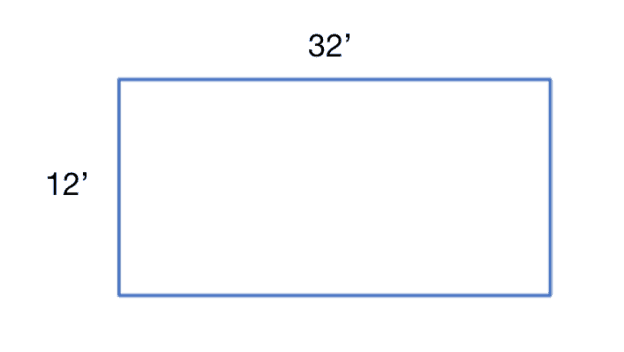
To find the perimeter of the above rectangle we'd add up the all of the sides. We're only given one length and one width, but we know that the opposite sides have the same measurements. So we would just add the width twice to the length twice. \( 12+12+32+32=88 \). We can also use multiplication. \( 2 \times 12 + 2 \times 32 = 88 \).
The formula says to use two times the length plus two times the width. Which is the length and which is the width? Usually, the longest side is the length, but it really doesn't matter which one you put where when calculating.
Perimeter of a Rectangle Quiz
What is the perimeter of the following shape?
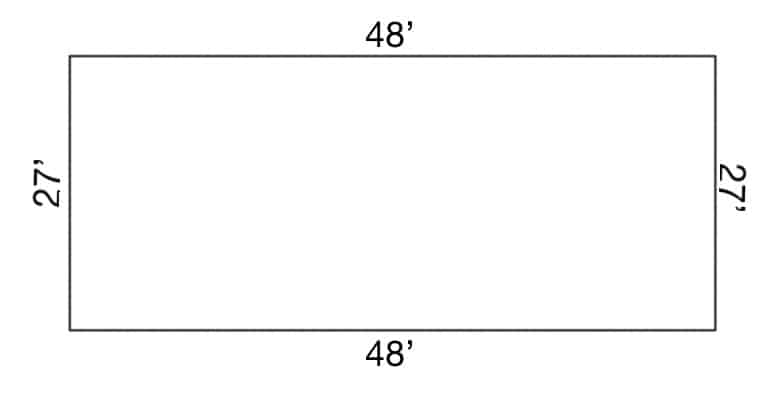
- 1.296
- 150
- 45
- 27
Click for the Answer and Explanation
Answer: 150
Explanation: \( 27+27+48+48=150 \) We calculate perimeter by adding up the lengths of all of the sides.
Perimeter of a Triangle
\( perimeter=a+b+c \)
The variables a, b, and c are the lengths of each side.
To calculate the perimeter of a triangle, simply add up all the sides.

The perimeter for the triangle above is \( 20+12+27=59 \).
Circumference of a Circle
\( perimeter=2 \times \pi \times radius \)
So far all of the shapes have had nice straight lines for each side, but how do you find the perimeter of a circle? Officially a circle doesn't have a perimeter because mathematicians decided to call the length around a circle its circumference.
To find the circumference of a circle you multiply twice the radius by \( \pi \) (pronounced "pie"). What's the radius? That's the distance from the center of a circle to the side of the circle. What's \( \pi \)? It's the ratio between the circumference and diameter of a circle. The diameter is the the distance across the entire circle (twice the radius). \( \pi \) is a long decimal number but for our purposes we'll round it to the hundredths place and use the value 3.14.

The radius of the above circle is three. \( 3 \times 3.14 = 9.42 \). The circumference (or perimeter) of the circle is 9.42'.
Perimeter of Nonstandard Shapes
To find the perimeter of any nonstandard shapes simply add the lengths of all the sides.
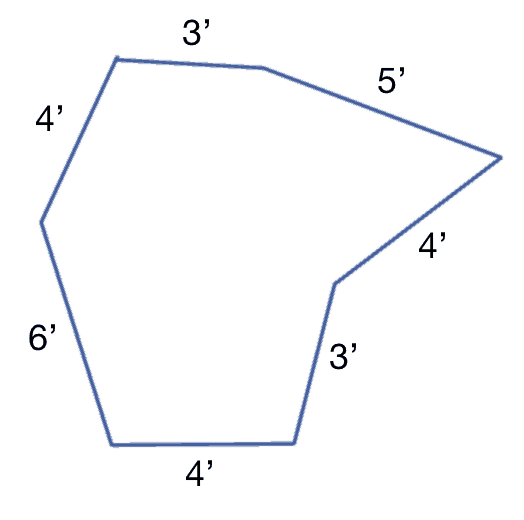
\( 3+5+4+3+4+6+4=29 \)
Area
The area is the amount of space that a space takes up in two different dimensions, length and width. One way to think of it is the amount of paint you'd need to cover a shape. A shape with double the area of another shape would need double the paint.
Paint's actually a great example because how much paint they'd need is a question your clients or customers might ask.
Area of a Square
\( area = length^2[ \)
To calculate the area of a square multiply the length by the width. Since all the sides are the same we can simplify the formula and just square the length. That mains raising it to the second power.
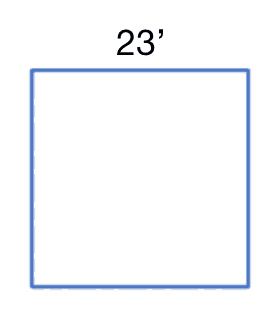
Let's calculate the area of the square above by squaring the length.
\( 23^2=539 \)
But notice that we didn't just multiply 23 by 23. We also multiplied feet by feet. A foot multiplied by a foot is a square foot, which you might see written as \( feet^2\) or \(ft^2 \). Anytime you see a measurement in square feet you know you're dealing with an area.
Since a square is a special type of rectangle you can also use the formula for a rectangle. That makes one fewer formula to memorize!
Area of a Rectangle
\( area=length \times width \)
To calculate the area of a rectangle, multiply the length by the width.
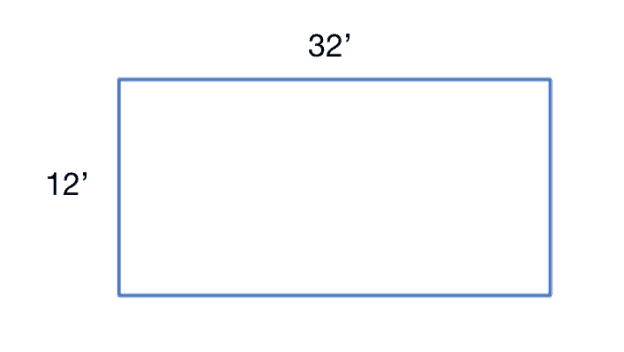
\( 12 \times 32 = 384 \). The area of the rectangle above is \( 385 \space ft^2 \).
Area of a Rectangle Quiz
What is the area of the following shape?
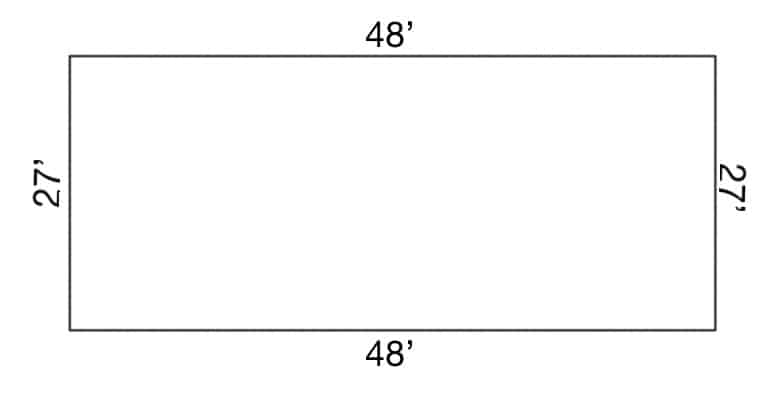
- 150
- 1,296
- 27
- 48
Click for the Answer and Explanation
Answer: 1,296
Explanation: \( 27 \times 48 = 1,296 \) The area of a rectangle is calculated by multiplying the length by the height.
Area of a Triangle
\( area=base \times height \div 2 \)
The area of a triangle is one-half the base times the height.
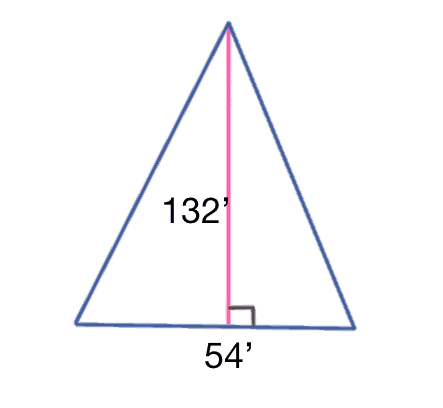
In the triangle above, the base is 54 feet. The height (the pink line) is 132 feet. Notice that the height is not necessarily the length of a side. That's the case in the triangle above.
But imagine if we broke the triangle in half at the pink line. We'd then have two triangles and the length of one of the sides would be the height. That's because they are right triangles (one of the angles is exactly 90 degrees).
Let's stop imagining and get back to the original blue triangle. \( 132 \times 54 \div 2 = 3,564 \). The area of the triangle above is \( 3,564 \space feet^2 \).
Area of a Circle
\( area=\pi \times radius^2 \)
or
\( area=3.14 \times radius^2 \)
To calculate the area of a circle multiply \( \pi \) by the radius squared (remember that means times itself).
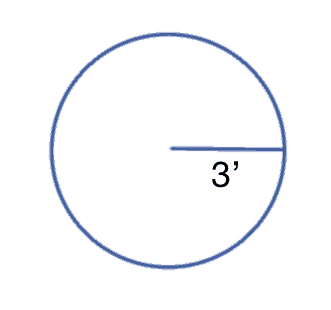
In the circle above the radius is 3 feet. The calculation would be \( \pi \times 3^2 \). Remember to calculate the exponent first so you don't break the rules of PEMDAS and accidentally get the wrong answer.
After calculating the exponent our new calculation would be \( \pi \times 9 \). After you plug \( 3.14 \times 9 \) into your calculator you'll get the answer of \( 28.26 \space ft^2 \).
Area of Nonstandard Shapes
The area of nonstandard shapes can be calculated by combining all of the rules we've learned above.
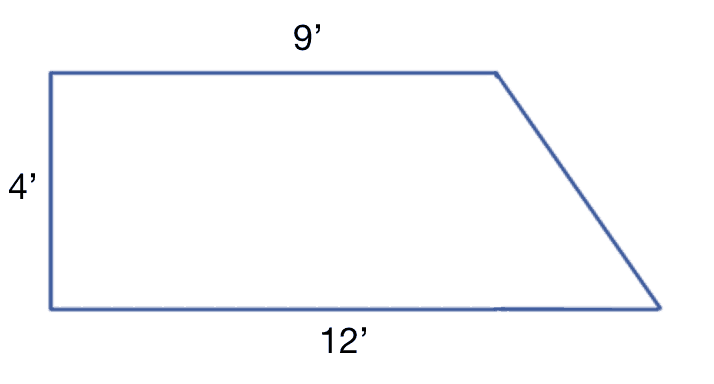
Your first reaction might be to think that this problem is impossible because I haven't given you a formula for it, but if you look closely you'll see a triangle next to a square.
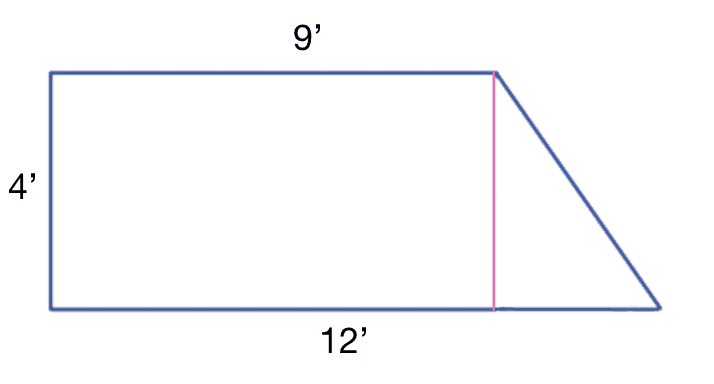
Your first reaction might be to think that this problem is impossible because I haven't given you a formula for it, but if you look closely you'll see a triangle next to a square.
I added a pink line above to help. The next step is to fill in the missing measurements. We actually have all of the information we need to do so.
Obviously the height of the triangle is going to be 4' because it's the other side of the rectangle that we created by drawing the line.
We also know that the width of our rectangle is 9' but the width plus the base of the triangle is 12'. So we simply subtract 9 from 12 to find the base of the triangle.
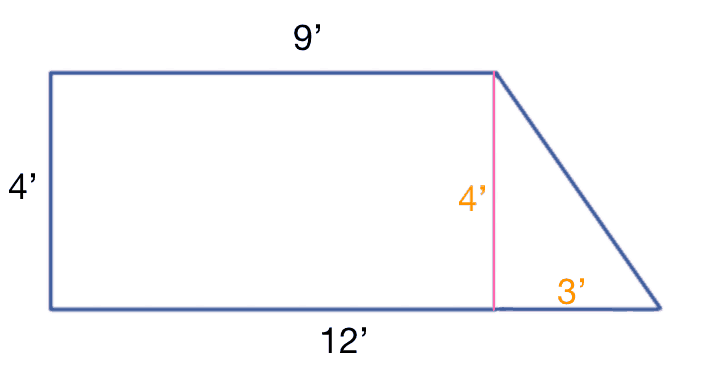
Now we have to find the area of the square and the area of the triangle and add them together.
Let's start with the square first. Remember that the formula is \( area=length \times width \).
Plugging in our length of nine (don't confuse the 12 as the length since that measurement includes the base of the triangle) and width of four we get \( 9 \times 4 = 36 \). The area of the rectangle is \( 36 \space feet^2 \).
Let's move on to the triangle. Remember the formula is \( area=base \times height \div 2 \). The base of the triangle is 3' and the height is 4'. \( \frac{1}{2}\times4\times3=6 \). The area of the triangle is \( 6 \space feet^2 \).
Finally we add the area of the rectangle to the area of the triangle. \( 36+6=42 \). The area of the entire nonstandard shape is \( 42 \space feet^2@ \).
Volume
The volume of an object is how much physical space it takes up in three dimensions. Recall the area had to do with two dimensions: length and width. The third dimension used to calculate the volume is the height.
To calculate the volume of any basic shape, all you really have to do is find the area and then multiply by the height.
Volume of a Cube
\( volume=length^3 \)
A cube is an object where the length, width, and height are equal. Think of it as a square extended out to be as high as the length or width. Since the length, width, and height are equal we simply “cube” that one measurement. To “cube” a number is to raise it to the exponent of three.

All of the sides in the example cube above measure 4'. Let's plug that into the formula. \( 4^3=64 \). We also multiplied feet by feet by feet so we get an answer that is in cubic feet, or \( feet^3 \). The cube above has a volume of \( 34 \space feet^3 \).
I used the length in the formula above, but you can use the length, width, or height since they are all equal if the object is a cube.
Also, since a cube is a special kind of rectangular prism you can also use that formula. That makes one fewer formula to memorize!
Volume of a Rectangular Prism
\( volume=length \times width \times height \)
A rectangular prism is a rectangle that has a height. To calculate the volume of a rectangular prism you multiply the length by the width by the height.
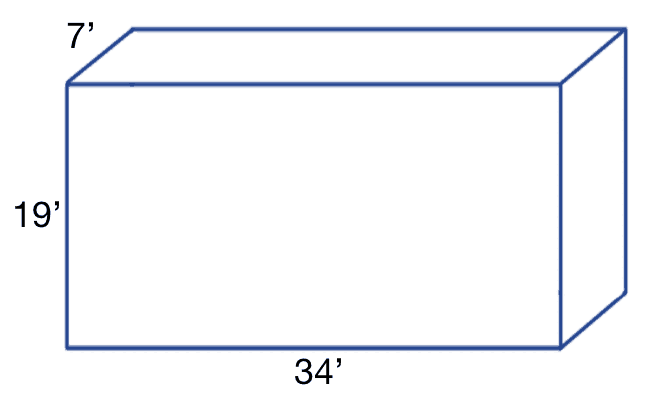
We multiple the length, width, and height of the above triangle to find its volume. \( 34 \times 19 \times 7 = 4,5224 \). The rectangular prism above has a volume of \( 4,522 \space ft^3 \).
Volume of a Rectangular Prism Quiz
What is the volume of the following shape?
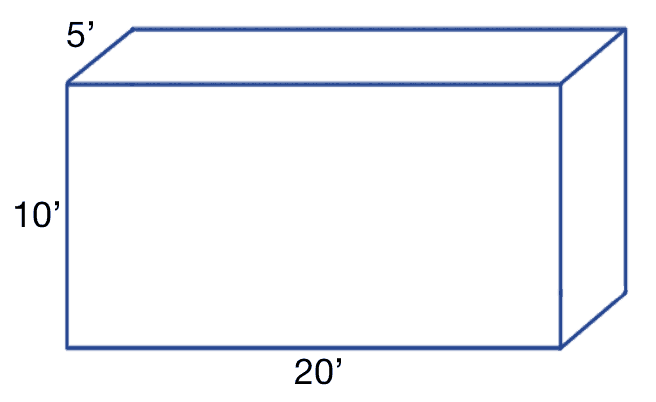
- \( 1,000 \)
- \( 1,000 \space ft^3 \)
- \( 1,000 \space ft \)
- \( 1,000 \space ft^2 \)
Click for the Answer and Explanation
Answer: \( 1,000 \space ft^3 \)
Explanation: To determine the volume of a rectangular prism we multiply the length by the width by the height. \( 10 \times 20 \times 5 = 1,000 \) Volume is expressed in cubic feet so the answer is \( 1,000 \space ft^3 \)
Volume of a Triangular Prism
\( volume=base \times height \div 2 \times length \)
A triangular prism is a shape with a triangular base that has height.
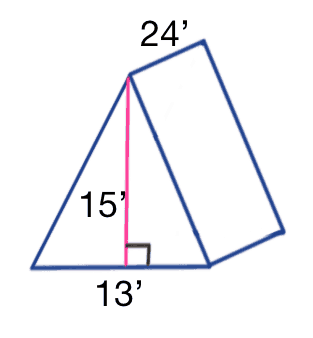
The image above is a triangular prism, but it's laying on its side. If you placed the triangle side down you would see a standard triangular prism. Why'd I draw it this way? First it's easier, but what's more important is that it looks like the top of a roof, which makes a lot more sense since this is about real estate.
Plugging our numbers into the formula we get \( 15 \times 13 \div 2 \times 24=2,300 \). The volume of the triangular prism above is \( 2,300 \space feet^3 \).
Volume of a Pyramid
\( volume = length \times width \div 3 \times height \)
A pyramid differs from a triangular prism because it has a rectangular base.
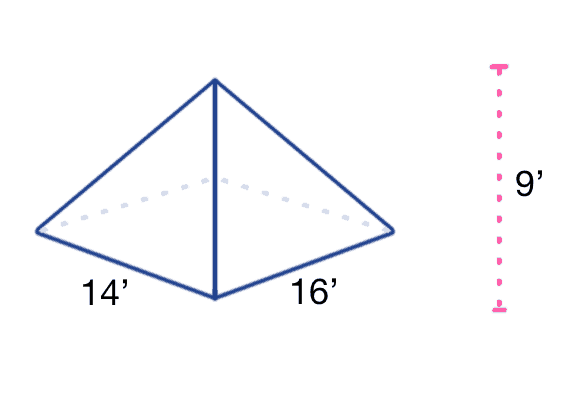
You might look at the bottom of the pyramid and think that it's a square because it looks like one. Don't trust how the drawings look because most of the time they are not drawn to scale and sneaky test writers try to trick you that way. Always trust the numbers instead of how the drawings look.
To get the volume of a pyramid, we calculate the area of the rectangular base, divide it by three, and then multiply by the height of the pyramid.
\( 14 \times 16 \div 3 \times 9 =672 \). The volume of the pyramid above is \( 672 \space feet^3 \).
Volume of a Cylinder
\( volume=\pi \times radius^2 \times height \)
or
\( volume=3.14 \times radius^2 \times height \)
To get the volume of a cylinder we get the area of the circle base and then multiply it by the height.
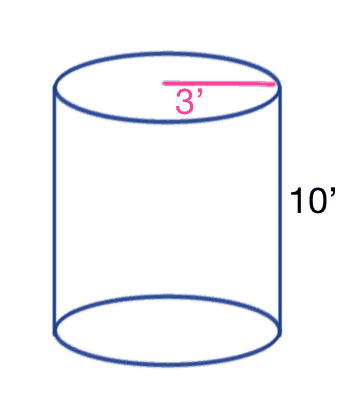
The radius of the cylinder above is 3' and its height is 10'.
\( 3.14 \times 3^2 \times 10 =282.6 \)
The cylinder has a volume of \( 282.6 \space feet^3 \).
Real Estate Geometry Terms
After all of that Geometry review, it's finally time to apply it to real estate problems.
Number Conversions
| Measurement | Measurement | Measurement |
|---|---|---|
| 1 foot = | 12 inches | |
| 1 yard = | 3 feet | |
| 1 mile = | 1,760 yards = | 5,280 feet |
| 1 square foot = | 144 square inches | |
| 1 square yard = | 9 square feet | |
| 1 cubic yard = | 27 cubic feet | |
| 1 acre = | 43,560 square feet | |
| 1 square mile = | 640 acres = | 1 section |
| 1 township = | 36 sections |
Frontage
What do you picture when you think about the front of a property? If you're like me you think of the part that runs along the road. If you stood in the middle of the road and looked at the property you'd be looking at its front. That makes remembering the following term super easy. The length of a property that runs along a street or streets is known as the frontage.
Note that some exam questions might mention frontage along a body of water like an ocean, lake, or river. The problems are calculated the same way, but use the frontage along the body of water instead frontage along a street. But if the problem doesn't expressly state that the frontage is along something other than the street always assume the problem is asking for street frontage.
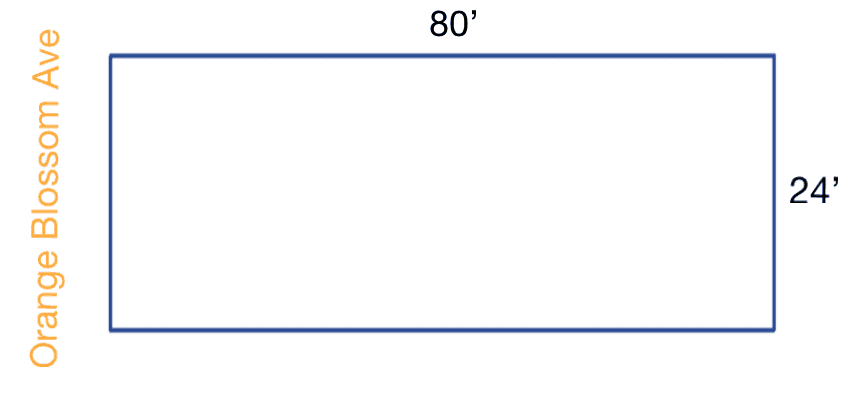
Suppose you were going to show this property on Orange Blossom Avenue to a customer. What would you say if the customer asked you what the frontage was? We can see that this property is a rectangle and the shorter side is the one that runs along Orange Blossom Avenue. This property has a frontage of 24 feet.
Frontage Quiz
How many feet of frontage does this property have on Apple Ave?
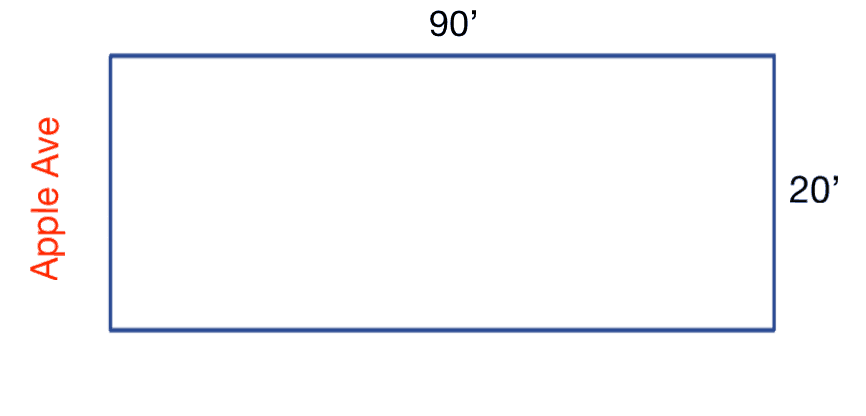
- 20'
- 90'
- 1,000'
- None
Click for the Answer and Explanation
Answer: 20'
Feedback: This property is a rectangle, so it has the same amount of frontage as the width of the other side of the property, which is 20'
Acreage
\( acreage = feet^2 \div 43,560 \space feet^2 \)
How would you figure out the acreage of the property on Orange Blossom Ave in the frontage example above? The first step is to find the area. \( 80 \times 24 = 1,920 \). The area of this property is \( 1,920 \space feet^2 \) but you need the number in acres so let's use the formula. \( 1,920 \div 43,560 = .044 \). This property is .044 of an acre.
Of course you probably won't get an acreage problem that is this easy to solve. You'll probably get a problem where you first have to calculate a nonstandard area so it's also very important to have all of the area formulas memorized.
Acreage Quiz
How many acres is the property on Apple Ave pictured in the frontage quiz above?
- 4.500
- 0.041
- 1,800
- 24.200
Click for the Answer and Explanation
Answer: 0.041
Feedback: The first step is to find the area \( 90 \times 20=1,800 \) The area of this property is \( 1,800 \space feet^2 \) but you need the number in acres so let’s use the formula \( 1,800 \div 43,560=0.041 \) This property is 0.041 of an acre. We rounded to thousandths because all of the choices were that way.
Describing Real Estate
There are three different ways to describe real estate and only two of them require math.
- Metes and bounds
- Lot and block (also called the Subdivision plat system)
- Government Survey System
Metes and Bounds
The metes and bounds system isn’t used in new developments but was standard at the beginning of the United States.
It uses monuments to describe land. An example might be “Starting at the old oak tree head 20 feet West, then make a 90 degree turn West and head 90 feet…”
Obviously as the old oak tree grew or was chopped down it became difficult to measure the land.
You probably won’t see a question about this on the exam except for a definition. They might use a street name on the test instead of an old oak tree.
Lot and Block
The lot and block method (also called the Subdivision plat system) requires little to not math because all of the boundary lines, streets, actually measurements, and easements are recorded in a publicly available plot map, known as a plat.
You will not likely see a question about this other than perhaps a definition question.
Government Survey System
The Government Survey System does require that you know some math so let’s focus there.
This survey system contains a six mile by six mile square that’s divided into 36 square miles. This is called a township.
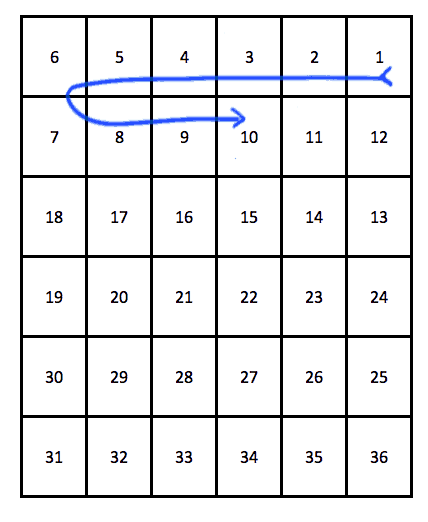
The squares are numbered from one to thirty six, starting with number one at the top right and then moving in an S curve for the rest of the swarms. That means the it will move from right to left on the next row, left to right on the one after that, etc. I've added a blue line above to help you start to see the S curve in how they squares are numbered. I only added the top of the S. You'll have to continue to complete it.
Remember that a square mile contains 640 acres. That means that each of these one square mile sections contains 640 acres.
Questions that you might see on the exam involve dividing sections into smaller parcels.
How many acres are in \( \frac{1}{4} \) of one section?
We know that one section contains 640 acres so \( \frac{1}{4} \times 640 = 160 \). There are 160 acres in a quarter of a section.
HINT: If you have a basic calculator you could divide by 4 instead of multiplying by \( \frac{1}{4} \). Many states allow only a basic calculator on the exam.
One half of one eighth of a section sold for $23,000 per acre. What was the total sale price?
We'll use the hint above to solve this one more quickly. Just like we could have divided by four instead of multiplying by \( \frac{1}{4} \) we can divide by all the denominators in a chain.
We're interested in \( \frac{1}{2} \) of \( \frac{1}{8} \) of a section. To get the total acreage we just divide 640 by two and the result by eight. That's what I meant by dividing the denominators in a chain.
\( 640 \div 2 \div 8 = 40 \)
There are 40 acres in this parcel of land. It sold for $23,000 per acre. Let's multiply to get the total price.
\( 40 \times $23,000 = $920,000 \)
The total price of the land was $920,000.
Government Survey System Quiz
How many acres are in \( \frac{1}{2} \) of one section?
- 160
- 640
- 320
- 220
Click for the Answer and Explanation
Answer: 320
Explanation: We know that one section contains 640 acres, so \( \frac{1}{2} \times 640 = 320 \). There are 320 acres in a half of a section.
One-quarter of one half of a section sold for $20,000 per acre. What was the total sale price?
- $1,600,000
- $80
- $3,200,000
- $6,400,000
Click for the Answer and Explanation
Answer: $1,600,000
Explanation: We’re interested in \( \frac{1}{4} \) of \( \frac{1}{2} \) of a section. To get the total acreage we just divide 640 by four and the result by two. \( 640 \div 4 \div 2 = 80 \) There are 80 acres in this parcel of land. It sold for $20,000 per acre. Let’s multiply to get the total purchase price. \( 80 \times $20,000 = $1,600,000 \) The total price of the land was $1,600,000.
The T Method: One Formula to Solve Most Real Estate Problems
Believe it or not there's one formula that you can use to solve most Real Estate math problems. I say most because it's not going to help you with questions about area or volume, but the majority of questions on the Real Estate License Exam have to do with percentages and rates.
Drawing the T
Questions about commissions, the annual interest rate, rates, taxes, and more are all the same type of math problem with different vocabulary used.
The good news is that there's one simple formula that you can use to solve most of these rate problems. It's called the T method. Why's it called the T method? It's because we start by drawing a big T.

Beautiful, isn't it? The next step is going to look a little weird, but just hang in there.
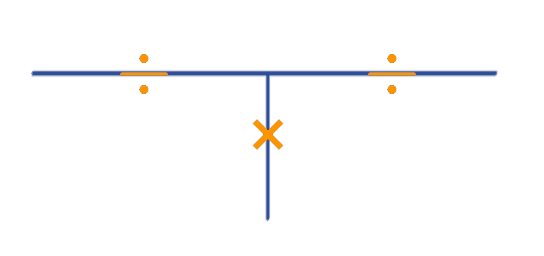
In a little while we're going to be putting a number at the top of the T, another number on the bottom left, and another on the bottom right. But before we get there let's put in some letters.
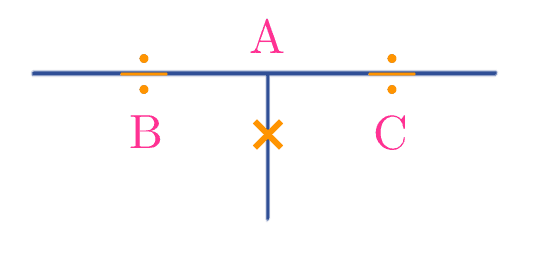
Now we can talk about what those operation symbols mean. The horizontal line of the T shows us the numbers that need to be divided and the vertical line shows us the numbers (technically letters in this example) that need to be multiplied.
In your problems you'll only have two of these numbers. If you were given A and B you'd divide A by B to get C. Does that make sense? If you think about it the T makes A over B look a bit like a fraction: \( \frac{A}{B}=C \). And we already reviewed that fractions are really division.
What if you were given A and C? You'd divide A by C to get B: \( \frac{A}{C}=B \).
The only one that's different is if you were given B and C. Can you guess what to do? If you said multiply you're right, but let me explain some more. The line between A and B not only makes A over B look like a fraction, but it also lets you know which operation (division or multiplication) to perform. There's only one line between B and C and it has a multiplication symbol. So we multiply.
If you can draw the T and remember what operations go with which lines then you're ready to move on.
Using the T
You won't be given As, Bs, or Cs in your problems. You'll be given a part, a total, or a percent. Each of those live in a specific place on the T.
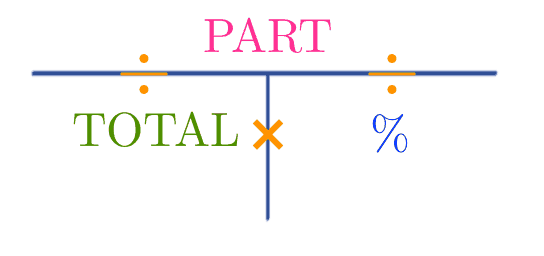
Now, we have to replace the operations we learned with A, B, and C with the real formulas concerning the part, the total, and the percent (%).
\( \frac{PART}{TOTAL}=PERCENT \)
\( \frac{PART}{PERCENT}=TOTAL \)
\( TOTAL \times PERCENT = PART \)
If you ever have difficulty trying to figure out which number to put where It's usually best to start with the percentage. That's because it is usually pretty straightforward. You're either given a percentage or asked to find a percentage or rate.
It's the next two that might be more difficult, but the total is almost always the larger number and the part is almost always the smaller number. So once you figure out which number should be bigger and which should be smaller those are easy too.
We're going to be using the T Method to solve many problems in the upcoming sections so it will be very helpful for you to memorize the final picture above before moving on.
The T method also helps you if you forget how to calculate any of the items that you'll learn later. Whether it's commissions, appraisals, or interest rates you can easily recognize that you'll be using the T method if you're given two of the three numbers.
Even if you forget how the T works for a specific topic you'll probably get the question right if you just plug the numbers into the T and calculate.
Commissions
Let's face it. You probably don't want to be a real estate agent just to help others buy and sell property entirely out of the goodness of your heart. You probably want to make money too.
Real estate agents make commissions off the sale of property. The commission that is received is based on the selling price of the property and a percentage that was negotiated between the real estate agent and seller when the house was listed.
Because this is how real estate agents get paid, many of them are very interested in (and often excited about) calculating commissions.
So if we're going to start practicing with the T method it's probably the most encouraging to start by seeing how much agents can get paid.
If you know how much money you would make off the next property sale, then you also know how much you can invest in marketing and any other expenses. If it's going to be a small commission then you might not want to spend that much, but if the commission will be big you might want to spend more.
Calculating Commission
Broker Betty sold a house for $250,000. The owner of the house had agreed to pay Betty a 6% commission. What was the dollar value of Betty's commission?
Let's use the T method to solve this problem.
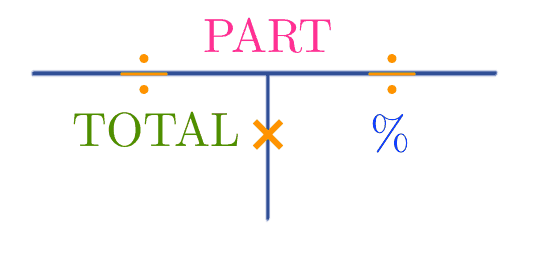
We're given the total sale price of the home ($250,000), the percentage (6%) and are asked to find the part (the dollar value of the commission). Let's plug this into the T.
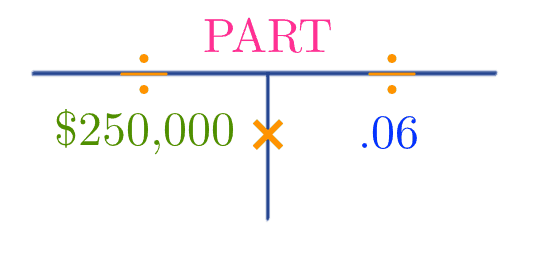
Notice that I converted 6% into the decimal .06. That's because it's much easier to enter it into a calculator.
Looking at the T we see that all we have to do to solve this problem is to enter \( $250,000 \times .06 \) into our calculator. When we do that we'll see that Betty's commission was $15,000.
Calculating Commissions Quiz
Broker Bill sold a house for $350,000. The house owner had agreed to pay Bill a 7% commission. What was the dollar value of Bill's commission?
- $50,000
- $12,250
- $24,500
- $122,500
Click for the Answer and Explanation
Answer: $24,500
Explanation: \( $350,000 \times .07 = $24,500 \
Calculating Commission Rate
Broker Bill sold a house for $375,000 and received a commission check for $18,750. What was Bill's commission rate for the sale?
Let's use the T method to solve this problem.
We're given the total sale price of the home ($350,000), and the part ($18,750) and we're asked to find the commission rate (percentage).
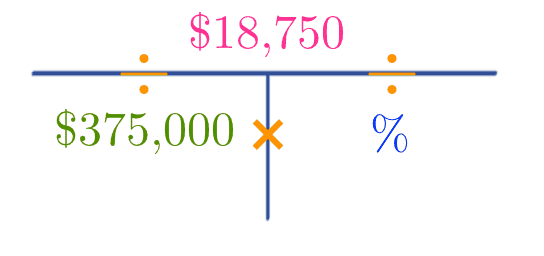
The T makes it clear that to solve this problem all we have to do is divide $18,750 by $375,000. After putting \( $18,750 \div $375,000 \) into our calculator we get the answer .05, which we then convert to 5%.
Calculating Commission Rate Quiz
Broker Betsy sold a house for $425,000 and received a commission check for $21,250. What was Betsy's commission rate for the sale?
- 5%
- .05%
- 20%
- .20%
Click for the Answer and Explanation
Answer: 5%
Feedback: \( $21,250 \div \$425,000=.05 \)
Finding Sales Price from Commission
Broker Bob always charges a 5% commission rate for every house that he sells. He sold a house and received a commission of $33,750. What was the selling price of the house?
This problem is very easy to solve using the T method.
We know the percentage (5%) and the part ($33,750). All we need to do is figure out the total selling price.
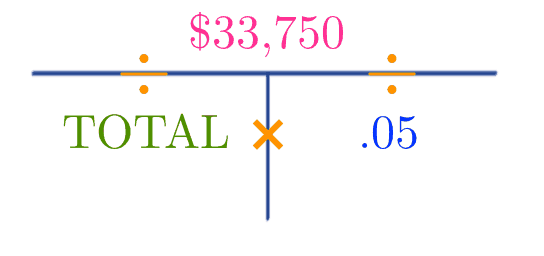
\( $33,750 \div .05 = $675,000 \)
The house sold for $675,000.
I hope you're starting to see how easy these types of problems are to solve by using the T method.
Finding Sales Price from Commission Quiz
Broker Billy always charges a 6% commission rate for every house that he sells. He sold a house and received a commission of $45,300. What was the selling price of the house?
- $271,800
- $45,300
- $755,000
- $709,700
Click for the Answer and Explanation
Answer: $755,000
Explanation: \( $45,300 \div .06 = $755,000 \)
Commission Splits between Brokers and Salespersons
Here's some bad news. If you're a salesperson you don't get to keep the entire commission. It's split between you and your broker. How it's split is negotiable and varies between brokerages or even within the same brokerage.
So that means you'll know your commission split because that's one of the things you and your broker will agree on before you start working, but I don't know what it will be and the test writers don't know so you'll be asked to solve hypothetical problems.
The good news is that you'll be given all of the information you need in the problem and you can use the T method.
Your brokerage received a $14,500 commission. You have a commission split with your broker and receive 40%. How much commission did you earn?
Let's use the T method to solve this problem.
We're given the total commission earned by the brokerage ($14,500) and the percentage that you'll receive (40%) and are asked to find the part (your commission).
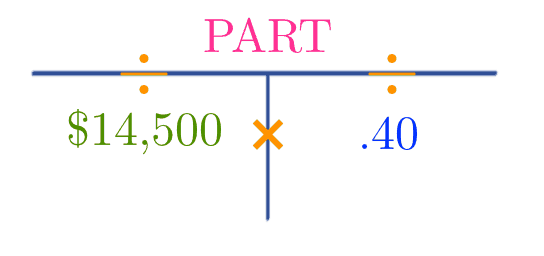
We can see that to solve this, we need to enter \( $14,500 \times .40 \) into our calculator. When we do, we get the answer $5,800, which is your commission.
Commission Splits between Brokers and Salespersons Quiz
Your brokerage received a $28,750 commission. You have a commission split with your broker and receive 50%. How much commission did you earn?
- $14,375
- $28,750
- $5,750
- $143,750
Click for the Answer and Explanation
Answer: $14,375
Explanation: \( $28,750 \times .50 = $14,375 \)
Splitting Commissions between Brokerages
It's rare for a buyer and a seller to both be represented by the same brokerage. Usually the seller is represented by one brokerage and the buyer is represented by another.
The commission split between brokerages is agreed upon in advance. The brokerage that represents the buyer is typically called the "listing" or "seller's" broker, agent, or side and the brokerage that represents the buyer is typically called the "buyer's" broker, agent, or side.
These types of problems can also be solved by the T method.
You are a salesperson and receive a 60% split with your brokerage. A house that you listed sold and earned a $23,000 total commission. Your brokerage will share 50% with the buyer's broker. How much commission will you earn?
There's something new about this problem. We actually have to use the T method twice. We'll use it the first time to find your brokerage's commission. The second time we'll use it to find out how much of that commission you'll get to keep.
Many of the math questions on the exam will involve more than one step like this.
We'll use the total commission earned off of the sale ($23,000) and the percentage that your brokerage gets to keep (50%) to find out how much money the brokerage took in.

\( $23,000 \times .50 = $11,500 \)
Your brokerage earned $11,500 off of the sale.
But that's not the answer that the question is looking for. The question asks how much money you'll make as the salesperson. Always pay attention and make sure you answer the right question. Test writers are sneaky and chances are that \( 11,500 \) would be one of the choices if you were asked this question.
Now we have a new total of $11,500 commission to our brokerage and we just need to figure out how much we get to keep just like in the last topic. Our commission rate is 60% so let's use another T.
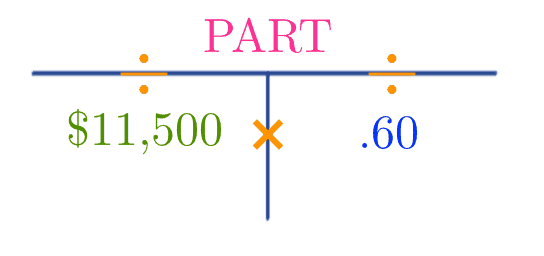
\( $11,500 \times .60 = $6,900 \) You earned $6,900 off of the sale. And that's the final answer.
Splitting Commissions between Brokerages Quiz
You are a salesperson and receive a 50% split with your brokerage. A house that you listed sold and earned a $43,000 total commission. Your brokerage will share 50% with the buyer’s broker. How much commission will you earn?
- $21,500
- $43,000
- $86,000
- $10,750
Click for the Answer and Explanation
Answer: $43,000
Explanation: We can solve this in one step by doing both Ts at once. \( $43,000 \times .50 \times .50 = $10,750 \)
Determining Listing Price
You are about to list a house for sale and the seller has told you that he needs to earn at least $250,000 after paying 6.5% commission. What is the minimum listing price to accomplish this requirement?
At first this looks like a normal T method problem, but it's slightly different. This is one of those places where it can be difficult to immediately recognize the total and the part. The percentage is actually a bit tricky on this one too.
Let's think about what we know so far. Since the seller wants to make at least $250,000 from the sale, after commissions then $250,000 plus some other number is the total. That means that $250,000 is the part.
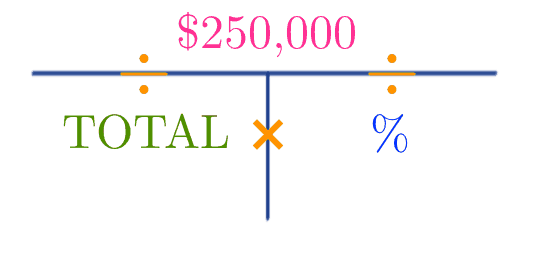
We know we need to find the total so now we have to figure out the percent. You might want to use 6.5% and then add that to $250,000, but if you did you'd be wrong. That's because $250,000 isn't 6.5% of the total. $250,000 plus a 6.5% commission is the total. So that means that $250,000 is actually 93.5% \( 100-6.5=93.5 \)) of the total. So let's add that to the T.
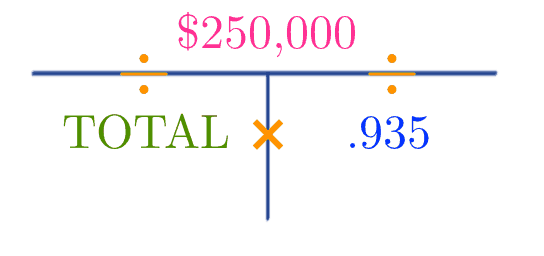
Now we know how to solve it. \( $250,000 \div .935 = $267,379.679... \). I'll round that up to $267,380 since our client did say he wanted to earn "at least" that much. So $267,380 is the minimum listing price for the client to earn $250,000 and pay a 6.5% commission.
You can also check your work by plugging these numbers back into the T in reverse. Checking your work is always a good idea if you're not sure about an answer and you have time.
If we did our work correctly then that means that \( $267,360-$250,000=$17,360 \) would be our commission. Let's plug that into the T along with the total sales price of $267,360 to see if we get 6.5% back. If we did we know we calculated it correctly. It might also help you believe me that this is how you solve this type of problem.
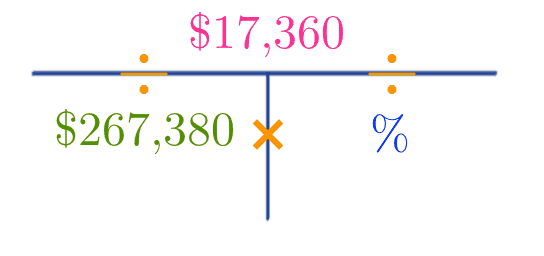
\( $17,360 \div \$267,380 \) does indeed equal the original commission of 6.5%. Granted there's a small rounding difference, but we know that we caused that ourselves when rounding up earlier.
Determining Listing Price Quiz
You are about to list a house for sale, and the seller has told you that he needs to earn at least $375,000 after paying the total 6% commission. What is the minimum listing price to accomplish this requirement?
- $375,000
- $397,938
- $395,000
- $398,937
Click for the Answer and Explanation
Answer: $398,937
Explanation: \( $375,000 \div (1-.06) = $398,936.17... \) so we'd list at at least $398,937
Advanced Commission Calculations
So far we've been dealing with relatively simple commission splits between brokers and salespersons. Fortunately, but unfortunately, some brokerages can get very creative in how they split commissions. It's fortunate because you'll usually make a more significant commission if you sell more. It's unfortunate because we have to use the T method more than once. There are also some steps before we can even start using the T.
Salesperson Sally works for Broker Betsy who charges a flat 6% commission rate on all of her listings and gives 40% of the total commission to the buyer's broker. Sally earns a 30% commission split on the first $250,000 of sales she brings in for the year and a 50% commission split on any sales over the first $250,000. Sally sold three houses last year. The sales prices were $175,000, $240,000, and $274,000. How much commission did Sally earn last year?
If you think that this problem looks more complicated than what we've seen so far you're right. You might even wonder where to start. To figure it out we look at the problem for clues.
We might be tempted to start at the individual home sales and figure out commissions based upon that, but that won't get us far. The question isn't asking us about individual sales; we're interested in Sally's total commission which is based on her total annual sales so we should start by adding up the three sales.
\( $175,000$240,000+$274,000=$689,000 \)
Sally sold $689,000 in real estate last year. Way to go, Sally!
Now we're getting somewhere. Sally is going to earn a 30% commission from the first $250,000 and 50% on the rest. The rest is \( $689,000-$250,000=$439,000@ \). Remember, though, that this is money paid is only going to be after Sally's broker gives 40% to the buyer's broker.
We're finally in the place where we can start using the T. We'll first figure out the broker's commission on the first $250,000 and then calculate Sally's portion based on her 30% commission. We're basically combining a lot of the steps we've learned so far.
We'll then figure out the broker's commission on the next $439,000 and then calculate Sally's portion based on her 50% commission. We'll then add the two commissions together to see what Sally made for the year.
Let's figure out the broker's commission on the first $250,000. We know that the broker charges 6% on all listings.
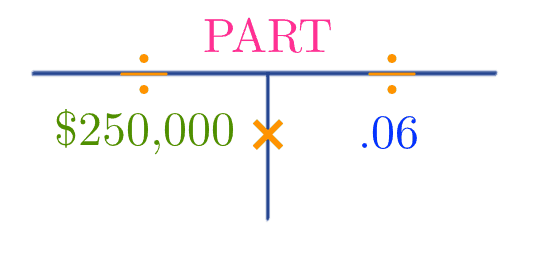
\( $250,000 \times .06 = $15,000 \). The broker's total commission on the first $250,000 was $15,000. The broker gives 40% to the buyer's broker so that means that 60% stays with Broker Betsy and Sally Salesperson's brokerage. So let's make another T to figure out how much stays in the brokerage.
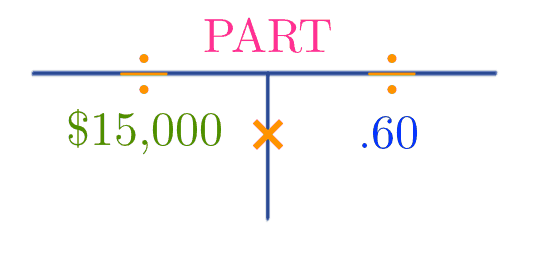
\( $15,000 \times .60 = $9,000 \)
$9,000 stays in Betsy's brokerage. Now we'll figure out how much will go to Sally. Remember that this is the first $250,000, and Sally gets to keep a 30% commission.
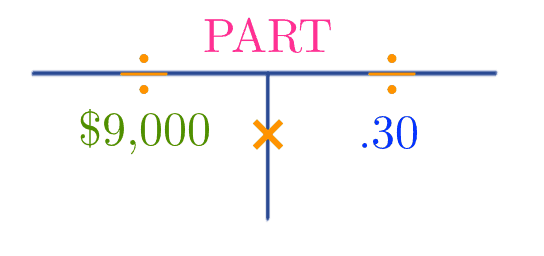
\( $9,000 \times .30 = \$2,700 \)
Sally earned $2,700 commission from her first $250,000 in sales last year. But that's only half the problem. We have to do the same thing again to figure out her commission on the rest of her sales.
But before we do that, I want to show you an easier method. We used three Ts, but we could have used one. We used three Ts because we had three percentages, but we could have put all the percentages on the percentage part and multiplied everything together. If we did that, the T would look like this:
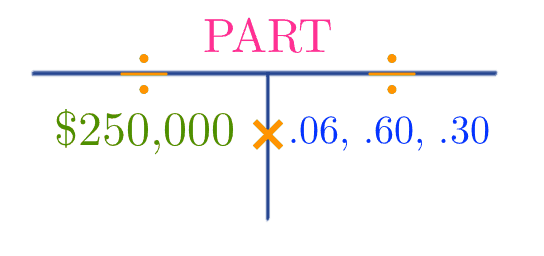
The $250,000 is still the total, but we've put all three percentages on the right. They are the brokerage's total commission (6%), what the brokerage keeps after the split (60%) and Sally's portion (30%).
So the new formula is \( $250,000 \times .06 \times .60 \times .30 = $2,700 \). We got the same answer with only one T!
Let's use this shortcut method to calculate Sally's commission on the rest of her sales ($439,000). She earns 50% on these sales. The rest of the numbers stay the same.
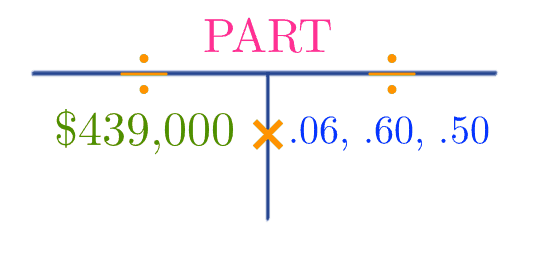
\( $439,000 \times .06 \times .60 \times .50 = $7,902 \)
Sally made $7,902 on the rest of her sales for the year. Now we have to add this to her commission on her first $250,000 to get our final answer.
\( $7,902+$2,700=$10,602 \)
Sally earned $10,602 in commissions for the year.
Advanced Commission Calculations Quiz
Salesperson Sally works for Broker Betsy who charges a flat 5% commission rate on all of her listings and gives 40% of the total commission to the buyer’s broker. Sally earns a 30% commission split on the first $300,000 of sales she brings in for the year and a 50% commission split on any sales over the first $300,000. Sally sold three houses last year. The sales prices were $175,000, $195,000, and $274,000. How much commission did Sally earn last year?
- $2,700
- $8,835
- $9,375
- $6,675
Click for the Answer and Explanation
Answer: $2,700
Feedback: Sally's total sales: \( $175,000+$195,000+$375,000=$745,000 \) Sally's sales after the first $300,000: \( $745,000-$300,000=$445,000\) Sally's commission on the first $300,000: \( $300,000 \times .05 \times .60 \times .30 = $2,700 \) Sally's commission on the rest: \( $445,000 \times .05 \times .60 \times .50 = $6,675 \) Add both of sally's commissions: \( $2,700+$6,675=$9,375 \)
Seller's Net
The seller's net (seller's net proceeds) is how much money the seller will receive after subtracting commissions, loan balances, settlement fees, repairs, and any other additional expenses.
It's pretty easy to calculate this. It's the sales price minus all of the expenses. If you see a problem about seller's net you're sure to see the selling price and a list of expenses. The expenses might be in dollar amounts that simply need to be subtracted or percentages that need to be calculated before they are subtracted.
A seller accepts a purchase offer of $189,000. The seller pays her broker a 6% commission, pays off a loan balance of $45,000, and pays various settlement costs that total 3% of the sales price. What are the seller's net proceeds?
There are two percentages here so there are two T calculations. The first is the 6% commission.
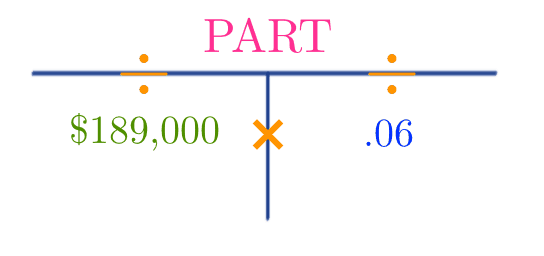
\( $189,000 \times .06=$11,340 \)
The seller owes $11,340 in commission. Now it's time to calculate the other settlement costs of 3%.
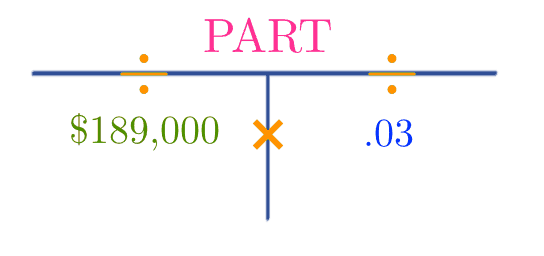
\( $189,000 \times .03 =$5,670 \)
The seller owes $5,670 in other settlement costs.
Now we just subtract the loan balance, commission, and other expenses from the sales price.
\( $189,000-$45,000-$11,340-$5,670=$126,990 \)
The seller's net proceeds are $126,990.
Seller's Net Quiz
A seller accepts a purchase offer of $255,000. The seller pays her broker a 7% commission, pays off a loan balance of $75,000, and pays various settlement costs that total 3% of the sales price. What are the seller’s net proceeds?
- $229,500
- $154,500
- $180,000
- $255,000
Click for the Answer and Explanation
Answer: $154,500
Feedback: \( $255,000-($255,000 \times .07)-($255,000 \times .03)-$75,000=$154,500 \)
Finance, Mortgages, and Interest
It probably goes without saying that interest rates have a lot to do with real estate because most buyers use mortgages to receive loans.
Interest is the price that is paid to obtain a loan. It is calculated as a fraction (expressed as a percent) of the total amount that was borrowed.
Your customers and clients will definitely have questions about calculating the interest rate and so will the commercial real estate exam.
Luckily we'll be able to use the T method for many of our interest rate calculations. In fact, I think you'll be pleased to see that you already learned how to solve some of these problem types in the previous sections. The main difference is the terms that we are using.
Equity
Equity is the current market value of a property minus the loans on the property. So if a homeowner's home was worth $100,000 on the open market, but the owner had a remaining loan balance of $25,000 on the property then the homeowner would have $75,000 in equity \($100,000-$25,000=$75,000\).
Henry Homeowner still owes $42,300 on the loan for his house. His neighbor just sold the exact same house for $267,000. Assuming that Henry's house can sell for the same price as his neighbors, how much equity does he have?
\( $267,000-$42,300=$224,700 \)
Assuming that Henry's house can sell for the same price as his neighbors, he would have $224,700 in equity.
You may also see equity problems that present percents, totals, or parts. These are simply T problems that you've had lots of experience with so far.
First Year's Amortized Interest
You borrow $375,000 at a 6.5% interest rate for 30 years in an amortized loan. What is the total amount of interest that you will pay during the first year?
When you read this question, you probably noticed an extra piece of information here that we haven't had to use yet, and that's the loan length. Our T method calculations have not yet had a time-based component to them.
We'll have to modify our T chart a bit to add time to our calculations, but we won't need to do so for this problem.
I've said before that test writers can be sneaky. Here, they want to confuse you by thinking you need to use time when you really don't.
But the joke's really on them because I haven't even covered how to include time yet, so we don't know what to do with that anyway. So take that, sneaky test writers!
This is simply a normal T problem because we're only considering the first year. That's because the interest rate is always an annual interest rate quoted each year and is always based on the unpaid balance remaining on the loan.
If we were figuring out the second year we'd have to subtract payments already made to the principal (the original loan amount) for the first year, but that's luckily not the case here.
The total is the principal amount being borrowed of $375,000 and the percentage is the interest rate of 6.5%.
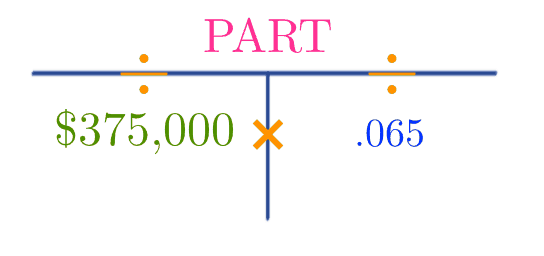
\( $375,000 \times .065 = $23,205 \) You would pay $23,205 in interest the first year of this loan.
First Month's Amortized Interest
You borrow $425,000 at a 6% interest rate for 30 years in an amortized loan. What is the total amount of interest that you will pay during the first month?
If you think this looks a lot like the problem from the last topic then you're right. All I did was change some of the numbers and ask for the first month's interest.
We'll solve the problem exactly like we solved the last one but we'll divide by 12 to change the annual interest into monthly interest.
Just like we could only do this for the first year in the last topic, we can only do this for the first month with the information that we've been given.
If we wanted to look at future months we'd need to know the monthly payment, which we haven't been given. Also note that the 30 years is there to confuse you again.
The total is the amount borrowed of $425,000 and the percentage is the interest rate of 6%.
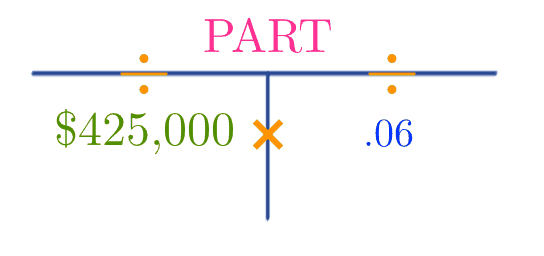
\( $425,000 \times .06 = $25,500 \)
You would pay $25,500 in interest in the first year of this loan.
But the question's not asking about the first year; it's asking for the first month, so we have to divide by 12. \( $25,500 \div 12 = $2,125 \).
You would pay $2,125 in interest in the first month.
First Month's Amortized Interest Quiz
You borrow $357,000 at a 5% interest rate for 30 years in an amortized loan. What is the total amount of interest that you will pay during the first month?
- $1,487.50
- $17,850
- $29,750
- $991.67
Click for the Answer and Explanation
Answer: $1,487.50
Explanation: \( ($357,000\times.05)\div 12 = $1,487.50 \)
Second Month’s Amortized Interest
You borrow $398,000 at a 5.75% interest rate for 30 years in an amortized loan. Your monthly payment is $2,322.62. What is the total amount of interest that you will pay during the second month?
This question is going to require a number of steps. We've already learned how to calculate the first month's interest so let's start there.
The first step is to calculate the interest for the first year.
The total is the principal amount borrowed of $398,000 and the percentage is the interest rate of 5.75%.
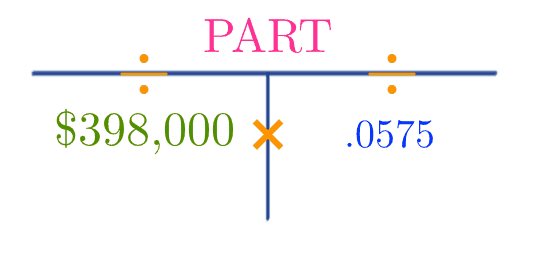
\( $398,000 \times .0575 = $22,885 \) The first year's interest is $22,885. We divide that by 12 to get the first month's interest. \( $22,885 \div 12 = $1,907.08 \) You will pay $1,907.08 in interest for the first month. It's not as simple to get the second month's interest, but it's still pretty easy. There are just more steps. A key fact to remember that in an amortized loan each payment is made up of a portion that is interest and a portion that pays off some of the principal. The first step is to find out how much principal is to be paid in the first month. For that we need to know the monthly payment. Lucky for us it's given in the problem. We subtract the first month's interest from the monthly payment to get the first month's principal payment. \( $2,322.62-$1,907.08=$415.54 \) The second step is to find out how much you will owe on the loan after deducting the principal paid during the first month. \( $398,000-$415.54=$397,584.46 \) You will owe $397,584.46 after your first month's payment. The third step is to start all over and calculate the new total interest paid over the next year based on the new amount owed.
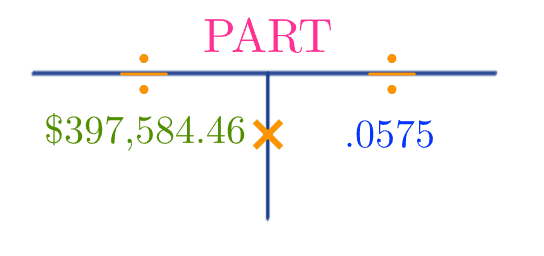
\( $397,584.46 \times .0575 = $22,861.11 \)
The total interest for the next 12 months is $22,861.11.
The fourth step is to find the interest paid the second month. We divide the total interest for the next 12 months by 12 to get the first month of that period's (which is actually the second month of the loan's) interest.
\( $22,861.11 \div 12 = $1,905.09 \)
And that's the answer. You'll pay $1,905.09 in interest during the second month.
But let's not stop there. Let's pretend that we were given this question instead of the one we worked through:
You borrow $398,000 at a 5.75% interest rate for 30 years in an amortized loan. Your monthly payment is $2,322.62. How much would you owe after the second month's payment?
The problem uses the exact numbers, but I changed the question. To answer that question we just need to do a couple more steps.
We'll find the amount of principal left by first subtracting the second month's interest from the monthly payment to find the principal paid during the second month.
\( $2,322.62-$1,905.09=$417.53 \)
And we'll subtract that from the remaining balance.
\( $397,584.46-$417.53=$397,166.93 \)
You'd owe $397,166.93 after the second month's payment.
That's the answer to our question but notice that you're also all set up to calculate the third month's numbers, but hopefully your exam won't be written by that mean of a test writer.
Second Month’s Amortized Interest Quiz
You borrow $400,000 at a 5% interest rate for 30 years in an amortized loan. Your monthly payment is $2,147.29. What is the total amount of interest that you will pay during the second month?
- $1,666.67
- $482.62
- $1,664.66
- $480.62
Click for the Answer and Explanation
Answer: $1,664.66
Explanation: First month's interest: \( ($400,000 \times .05)/12 = $1,666.67 \) First month's principal: \( $2,147.29 - $1,666.67 = $480.62 \) Amount owed after first payment: \( $400,000 - $480.62=$399,519.38 \) Next month's interest: \( $399,519.38 \times .05\div 12=$1,664.66 \)
Total Interest (Payment Given)
Your customer received an amortized mortgage loan of $165,000 at 4.5% interest for 30 years. The monthly payment is $836.03. Assuming the customer doesn't sell the property or refinance and makes all of the payments, what is the total interest that your customer will pay?
Here's another question with information that's meant to trick you. In fact, this problem is so easy that we don't even have to use the T method.
I know what you're thinking. There's a percent mentioned in the question and we've always used the T method when dealing with percents. That's true but the percent is also the piece of information that we don't need.
All we need to know is the loan amount, which is $150,000 as given in the question, and the total amount of payments.
The customer will be paying $836.03 per month for 30 years. 30 years is 360 months (\( 30 \times 12 = 360 \)). We'll get the total paid by multiplying $836.03 by 360. \( $836.03 \times 360 = $300,970.80 \)
The customer will make payments that equal $300,970.80. All we have to do is subtract the original loan amount to get the total interest paid. \( $300,970.80-$165,000=$135,970.80 \)
The customer will pay $135,970.80 total in interest over the life of the loan.
Note that test writers might add mortgage or homeowners insurance to the payment. If they do that they'll also tell you how much they cost per month. All you'll have to do is subtract those amounts from the monthly payment before multiplying by the number of payments.
Total Interest (Payment Given) Quiz
Your customer received an amortized mortgage loan of $186,000 at 5% interest for 30 years. The monthly payment is $998.49. Assuming the customer doesn’t move or refinance and makes all of the payments, what is the total interest that your customer will pay?
- $173,452.80
- $9,300
- $279,000
- $23,250
Click for the Answer and Explanation
Answer: $173,452.80
Feedback: \( ($998.48\times30\times12)-$186.000=$173,452.80 \)
Total Interest (No Payment Given)

I've changed some terminology because we only use the double T with interest rates, but it's exactly the same as the original T with time added to the mix.
The biggest number is the total loan. The smaller number (what we used to call the "part" is the amount of interest paid and the percent is the interest rate. Here's where it gets a little bit tricky. We always need to express the time as a decimal. If we were talking about a full year we'd put a one for time. If we're talking about a part of a year we'd express that as a decimal.
And it's really convenient that our example problem has a loan term of six months since that's part of a year. A year has 12 months so six months would be expressed as the fraction \( \frac{6}{12} \). When we divide six by 12 we get .50 (\( 6 \div 12 = .50 \)).
Let's plug all that information into our shiny, new double T.

Now, all we have to do is the multiplication. \( $20,000 \times .07 \times .50 = $700 \)
You would pay $700 dollars in interest on this loan.
Let's look at another problem.
How much interest would you pay on a $300,000 loan at 5% interest for fifteen years?
The only gotcha here is converting the time. Remember that we express time as a decimal in parts of a year. In this problem we actually don't have any parts of a year. We have 15 full years. So we just put 15 in our double T.

Now we do the multiplication. \( $300,000 \times .05 \times 15 = $225,000 \)
Total Interest (No Payment Given) Quiz
How much interest would you pay on a $200,000 loan at 6% interest for six months?
- $100,000
- $9,000
- $18,000
- $150,000
Click for the Answer and Explanation
Answer: $9,000
Feedback: \( $200,000 \times .06 \times .50=$9,000 \)
Interest Rate
You paid $9,000 per year in interest on a $75,000 loan. What was the interest rate?
This problem doesn't tell us how many years the loan was for, but it doesn't matter because it's going to be the same per year. Unless a problem states explicitly that the loan is amortized, then we can assume that the problem is asking for simple interest. With simple interest the same interest is paid every year. Simple interest also allows us to use the double T. Let's fill in what we know so far.

What do we do now? With the original T we always multiplied when we had all of the bottom numbers and we always divided when we had the top and one bottom number. It's actually pretty much the same way.
\( $9,000 \div ($75,000 \times 1) \)
Using the order of operations (PEMDAS) we first multiply all of the bottom numbers. We then divide the top number by their product.
If that terminology is confusing to you it might be a good idea to review the math terminology presented in the Basic Math section of this page.
And if all that's still confusing here's the next step. We solve what was in the parenthesis first.
\( $9,000 \div $75,000 \)
Okay, that was really easy because we're multiplying by one, but you won't always have a problem so easy. Now we can solve the problem.
\( $9,000 \div $75,000=0.12 \)
You paid 12% interest on the loan.
Interest Rate Quiz
You paid $15,000 per year in interest on a $100,000 loan. What was the interest rate?
- 15%
- 5%
- 10%
- 20%
Click for the Answer and Explanation
Answer: 15%
Explanation: \( $15,000 \div ($100,000 \times 1) = .15 = 15 \% \)
Mortgage Payments
You might be given a question in which you have to calculate the monthly payment in an amortized loan. This is super easy to do with a financial calculator, but these types of calculators are not allowed on the exam.
The state wants to know that you know how to figure this out with a basic calculator. :-(
But to figure it out with a basic calculator you'll need an additional piece of information which is sometimes called the payment factor or is expressed as an amount "per thousand."
That number will either be given to you directly in the problem or the state will provide you with an amortization table that you can use to find the factor.
What is the total monthly payment for a 15 year mortgage at 6% interest on a $300,000 mortgage? A 15 year mortgage at 6% interest has a payment factor of $8.439 per thousand.
The payment factor always means "per thousand" even if the problem on your exam doesn't use those words.
The first step is to see how many thousands we have in our loan amount by dividing the loan amount by 1,000.
\( $300,000 \div 1,000 = 300 \)
We have 300 thousands.
The next step is to multiply the number of thousands that we have by the payment factor to get the monthly payment.
\( 300 \times $8.439 = $2,531.70 \)
The payment on this loan is $2,531.70 per month.
Loan-to-Value Ratios
The loan-to-value ratio is a number that compares the appraised value of the home with a loan for that home. It's a method that banks use to evaluate risk and helps them to decide whether or not to give the loan.
Lower loan-to-value ratios, which mean that the borrower has more equity in the home, usually result in lower interest rates while higher loan-to-value ratios can mean higher interest rates.
A bank requires a loan to value ratio of 90% of the property's appraisal. The property appraised for $199,000. Assuming the buyer meets all other underwriting guidelines what is the maximum loan the buyer can take on this property?
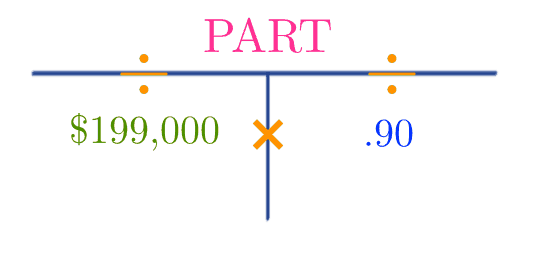
\( $199,000 \times .90 = $179,100 \)
$179,100 is the maximum loan amount according to the loan-to-value ratio and assuming that the buyer meets all other underwriting guidelines.
A home buyer receives a loan at 7% interest at an 80% loan to value ratio. The interest for the first year of the loan is $25,200. What is the appraised value of the property?
Solving this problem requires a number of steps. We first have to find the original loan amount. Since the interest rate is 7% and we've been told that the first year's interest is $25,200, we can use the T to find the original loan amount.
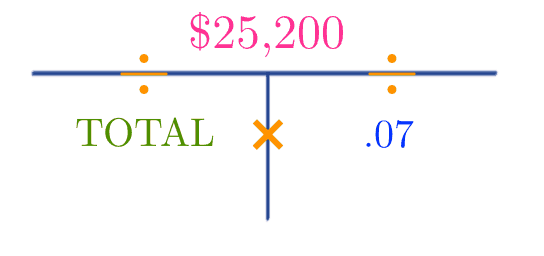
\( $25,200 \div .07=$360,000 \)
The original loan amount was $360,000. The loan was given at an 80% loan-to-value ratio so we can use the T again to find the original appraisal value.
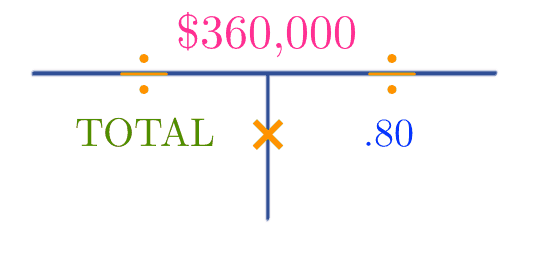
\( $25,200 \div .07=$360,000 \)
The original loan amount was $360,000. The loan was given at an 80% loan-to-value ratio so we can use the T again to find the original appraisal value.
Loan-to-Value Ratios Quiz
A bank requires a loan-to-value ratio of 90% of the property’s appraisal. The property was appraised for $250,000. Assuming the buyer meets all other underwriting guidelines, what is the maximum loan the buyer can take on this investment property?
- $225,000
- $250,000
- $25,000
- $275,000
Click for the Answer and Explanation
Answer: $225,000
Feedback: \( $250,000 \times .90 = $225,000 \)
Points & Origination Fees
A point is a prepaid loan discount of one percent of the loan amount in exchange for a lower interest rate.
For the Real Estate Exam all you really need to remember is that one point is 1% of the loan amount. From there you can solve just about anything using the T method. Like always, though, be on the lookout for any calculations that you need to make before using the T.
Brenda Buyer's bank is requiring that she pay $16,800 in points for a $560,000 loan. How many points is the bank charging?
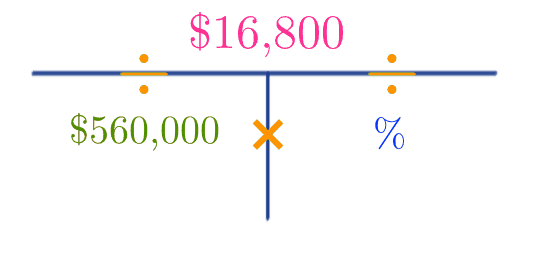
\( $560,000 \div $16,800 = .03 \)
Brenda's lender required her to pay 3%, or 3 points.
Bob the Buyer's lender is charging 3.5 points on a $254,000 loan. What is the dollar amount that Bob must pay at closing?
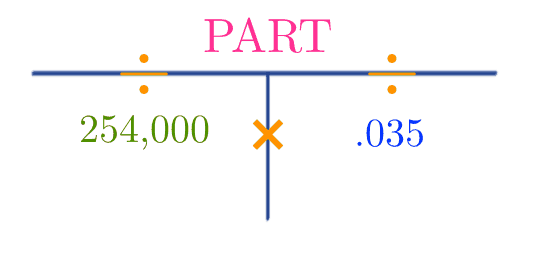
\( $254,000 \times .035 = $8,890 \)
Bob must pay $8,890 at closing for points.
An origination fee is the upfront fee that's charged by a lender for processing the loan. Often the fee is one percent so it's the same as a point. Sometimes the origination fee might be another percentage. In that case you'd use the standard T method.
Dave received a $678,000 loan with an origination fee of 0.5%. How much was the origination fee?
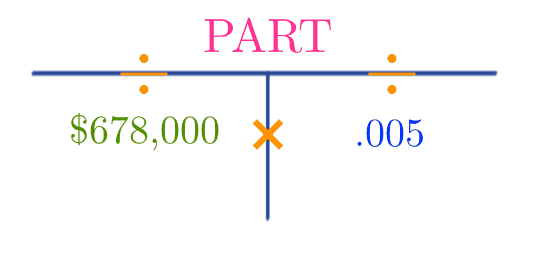
\( $678,000 \times .005 = $3,390 \)
Dave paid an origination fee of $3,390.
Points & Origination Fees Quiz
Brenda Buyer’s bank is requiring that she pay $23,250 in points for a $775,000 loan. How many points is the bank charging?
- 1
- 2
- 3
- 4
Click for the Answer and Explanation
Answer: 3
Explanation: \( $23,250 \div $775,000=.03=3 \%=3 \space points \)
Qualifying Buyers
A potential buyer may come to you and wonder if they would qualify for a loan. Lenders are typically the ones actually pre-qualifiying buyers but some customers might want a rough estimate from you before they go through the trouble of contacting a lender. They might also want help understanding their pre-qualification.
But the most important reason for covering this on this page is that you might be asked a question about qualifying buyers on your exam.
The critical definition that you need to know here is PITI, which stands for principal, interest, taxes, and insurance.
The PITI is the buyer's total monthly payment for the house including the principal and interest from the loan, property taxes, and home insurance. PITI is important even if the lender isn't holding taxes and insurance in escrow.
A buyer's monthly mortgage payment is $1,234, which does not include her annual property taxes of $1,500 and home insurance of $576. What is the buyer's PITI?
The buyer's monthly payment already includes the payment and interest portions of PITI so we just have to figure out the TI. Both the taxes and insurance are in annual numbers so we just add them and divide by twelve to get the monthly number.
\( ($1,500+$576) \div 12=$173\)
The buyer's TI is $173 per month. Now we just add the PI ($1,234) to the TI ($173).
\( $1,234+$173=$1,307\)
The buyer's PITI is $1,307.
Lenders typically establish a maximum PITI for a borrower based on a debt to gross income amount ratio. This is simply a percentage of the borrower's debt divided by the borrower's gross income amount.
A lender accepts a total debt to income ratio of 39% of a borrower's gross monthly income. A potential borrower with a gross annual income of $75,000 per year has student loan debt payable at $249 per month and a car payment of $575 per month. What is the maximum PITI that the lender will approve for this potential borrower?
We'll use the T method to find the maximum PITI assuming no other debts exist. PITI is interested in monthly calculations so we first find the borrower's monthly income.
\( $75,000 \div 12 = $6,250 \)
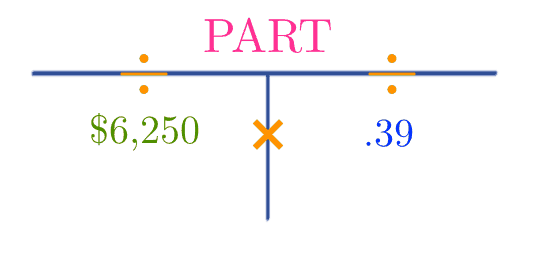
\( $6,250 \times .39 = $2,437.50 \)
$2,437.50 would be the answer if the lender was interred in a housing expense to income ratio, but the problem asked for a total debt to income ratio and gave some other monthly debt payments so the next step is to subtract them.
\( $2,437.50-$249-$575=$1,613.50 \)
The maximum PITI that this lender would approve for this borrower is $1,613.50.
Qualifying Buyers Quiz
A buyer’s monthly mortgage payment is $1,776, not including her annual property taxes of $2,500 and home insurance of $686. What is the buyer’s PITI?
- $413.50
- $1,776
- $2,041.50
- $4,962
Click for the Answer and Explanation
Answer: $2,041.50
Explanation: \( $1,776+(($2,500+$686)/12)=$2,041.50 \)
Taxes
Calculating taxes is a very important part of real estate math. Your customers might ask you about the taxes of a property and you might be required to calculate taxes to include them in your listings.
No one likes taxes, and you won't insult me if you don't like math either, but let's enter this section excited about doing tax math on our real estate exam because we know it's basically just practice for when you start your successful real estate career.
Taxes can be calculated in a number of ways. They can be calculated based upon an assessed value of the property, tenths of a penny, or mills.
We'll learn how to calculate real estate taxes using each of these methods in this section.
Assessed Value
Cities and other municipalities assess properties based upon a relationship between the actual market value and the value used to calculate taxes.
The value used to calculate taxes is called the assessed value and the ratio used to calculate it is called the assessment ratio. You might not actually see the term "assessment ratio" in a question, but it will be the number represented as a percent or decimal.
Questions about assessed value are very easy to solve and use the standard T method.
A county assesses property at 65% of market value. Sandra's house has a market value of $724,000. What is the value of the house for county tax purposes?
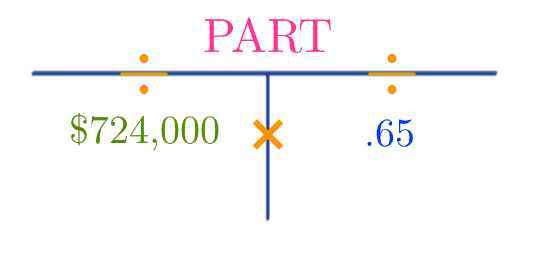
\( $724,000 \times .65 = $470,600 \)
The value of Sandra's house for tax purposes is $470,600.
A property is assessed at a value of $348,400 and has a market value of $520,000. What is this property's assessment ratio?
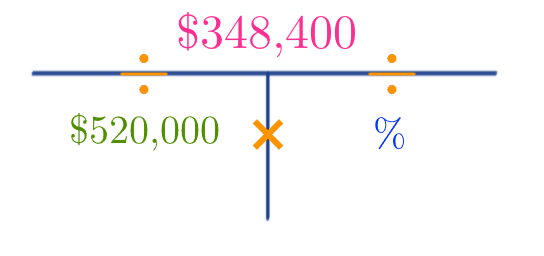
\( $348,400 \div $520,000 = .67 \)
The assessment ratio for this property is 67%
A property is assessed at 62% and has an assessed value of $452,250. What is this property's market value?
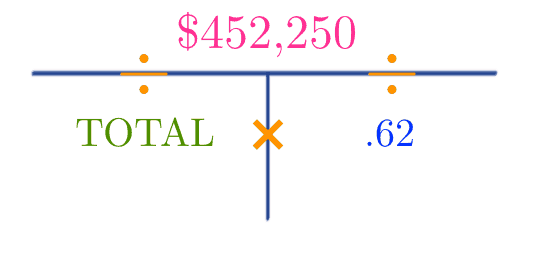
\( $452,250 \div .62 = $675,000 \)
This property's market value is $675,000
I don't know if you realized this, but we just completed each type of standard T method problem.
Each of these examples had a different value missing. That was a lot of T practice.
I also didn't explain each step this time since you're probably a T method expert by now, especially after those double T problems back in the interest rate section.
Assessed Value Quiz
A county assesses property at 70% of market value. Sandra’s house has a market value of $333,000. What is the value of the house for county tax purposes?
- $99,900
- $233,100
- $333,000
- $23,310
Click for the Answer and Explanation
Answer: $233,100
Explanation: \( $333,000 \times .70 = $233,100 \)
Equalization Factor
If a city assesses values the county can sometimes step in and make sure that each property owner in the county is paying the fairest amount of property taxes because cities may be assessing at different ratios.
To calculate this the county uses what is known as an equalization factor. This is typically a number above 100% that increases the assessed value so that county taxes are increased.
Let's take a look at an example.
A property has an assessed value of $125,000 with an equalization factor of 115%. On what value will the property be taxed by the county?
We have a total and a percent so we can place these into the T. Just keep in mind that 115% is actually 1.15 when going into the T.
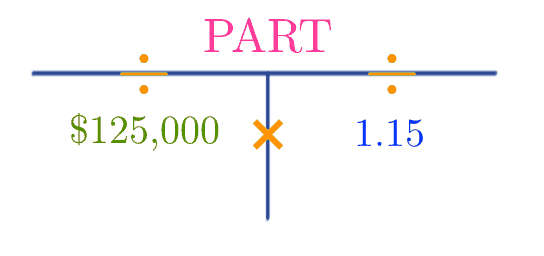
\( $125,000 \times 1.15 = $143,750 \)
This property would be taxed by the county at a value of $143,750.
Keep in mind that test writers like to stack many topics into one question. So you might see a question that wants you to find the assessed value, then use an equalization factor, and finally calculate actual taxes using one of the upcoming methods.
Mills
A mill is one-hundredth of a dime, a tenth of a cent, or a thousandth of a dollar. The usual definition is a tenth of a cent, but they are all equal.
If we think back to our lesson about decimals and place value a mill is the number in the thousandths place.
Why do they call it a "mill" when it's a thousandth and not a millionth? It goes back to the Latin word millesimum, which means "thousandth part." So that's a great term to use after all!
Peter's city taxes 23 mills and the assessed value of his property is $272,000. What are his taxes?
We can use the T method to solve this. We'll solve for the taxes that John owes, which would be the part. The total is his property value and the % would be the millage, which is already expressed as a decimal. If you think about it a millage value is really a percent.
If you're careless with your decimal points you might want to put the 2 (from 23) in the thousandths place, but if you did you'd be wrong.
23 thousandths actually starts in the hundredths place. So the millage is $0.023.
If that's a bit confusing to you just think about a dollar. A penny is a hundredth of a dollar, but if you have 46 pennies you wouldn't write it like this: $0.046 starting in the hundredths place. You write it like this $0.46 starting in the tenths place.
To keep things simple with mills just move the decimal point three places to the left. So 23 mills becomes $0.023 when expressed in dollars.
And the millage value of $0.023 is really just the same as a 2.3% tax rate, which is why our T works so beautifully.
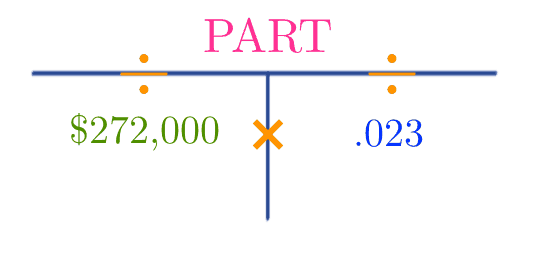
\( $272,000 \times .023 = $6,256 \)
Peter owes his city $6,256 in taxes.
Mills Quiz
Peter’s city taxes 27 mills and the assessed value of his property is $678,000. What are his taxes?
- $18,306
- $183,060
- $1,830.60
- $25,111.11
Click for the Answer and Explanation
Answer: $18,306
Explanation: \( $678,000 \times .027= $18,306 \)
Taxes per Hundred or Thousand
As if using mills instead of a simple percentage doesn't make taxes confusing enough, some municipalities tax in dollars per hundred of assessed property value.
Carlos owns a property that has an assessed value of $987,000. The tax rate in his municipality is $2.55 per hundred. What can Carlos expect to pay when he receives his property tax bill?
The first step is to remember that whenever we see the word "per," we're seeing a ratio and a ratio is really just a fraction. So "$2.55 per hundred" can be rewritten as \( \frac{$2.55}{100} \).
We need a decimal number to use in our T so we simply divide to convert the fraction to a decimal. \( $2.55 \div 100 = $0.0255 \). Now we have a number that looks just like we had after we moved the decimal point with mills. We're ready for the T.
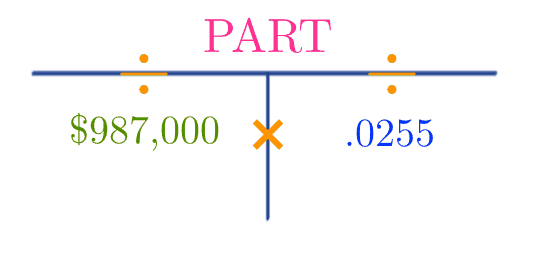
\( $987,000 \times .0255 = $25,168.50 \)
Carlos can expect to receive a tax bill for $25,168.50.
Some municipalities tax in dollars per thousand instead of dollars per hundred. We solve those the same way, except that we divide by 1,000 instead of 100.
Veronica owns a property that has an assessed value of $457,000. The tax rate in her municipality is $23 per thousand. How much are her taxes?
\( \frac{$23}{1,000}=$23 \div 1,000 = $0.023 \)
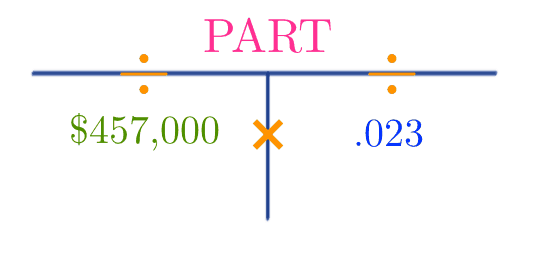
\($457,000 \times .023 = $10,511\)
Veronica's taxes are $10,511.
Taxes per Hundred or Thousand Quiz
Carlos owns a property that has an assessed value of $555,000. The property tax rate in his municipality is $2.45 per hundred. What can Carlos expect to pay when he receives his property tax bill?
- $1,359.75
- $135,975
- $13,597.50
- $2,265.31
Click for the Answer and Explanation
Answer: $13,597.50
Explanation: \( $555,000 \times .0245 = $13,597.50 \)
Tax Rate
Tax rate questions can also be asked in reverse like most questions where we can use the T method. You might be given taxes and a property value and asked to give back the tax rate.
Bonnie was taxed $7,475 on a property that was assessed at $325,000. What was her tax rate (percent)?
This is a very basic T problem.
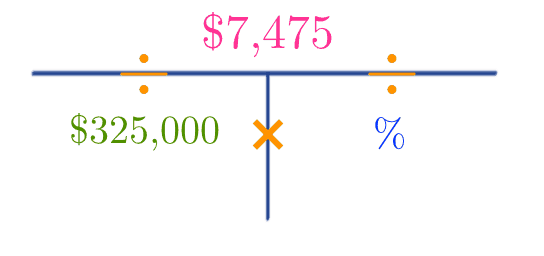
\( $7,475 \div $325,000 = .023 = 2.3\% \)
Suppose the question asked us to give the number in mills instead of a percent. We'd take .023 and move the decimal point three places to the right. The answer would be 23 mills.
If the question asked us to give the answer in dollars per hundred we'd simply multiply .023 by 100 to get $2.30.
And if the question asked us to give the answer in dollars per thousand we'd multiply .023 by 1000 to get $23.
Tax Rate Quiz
Bonnie was taxed $11,400 on a property that was assessed at $456,000. What was her tax rate (percent)?
- 2.5%
- 0.25%
- 0.025%
- 25%
Click for the Answer and Explanation
Answer: 2.5%
Feedback: \( $11,400 \div $456,000 = .025 = 2.5 \% \)
Transfer Tax
Transfer tax, also called conveyance tax or revenue stamps, is a service fee charged by jurisdictions for transferring the titles of properties to different owners.
They can be expressed as any ratio but are solved exactly how we've solved the other tax problems so far.
Jake sold his house for $125,000. The transfer tax is $137.50. In Jake's state transfer taxes are calculated per $500 of property value. What was the rate of Jake's transfer tax (per $500)?
The first step is to figure out what percent of $125,000 is $137.50. The T was made to do just that!
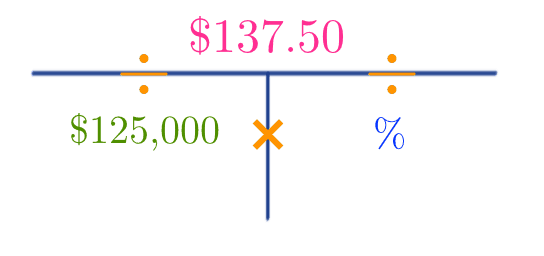
\( $137.50 \div $125,000 = .0011 \)
The transfer tax is 0.11%. Since we need this as a number per $500 we simply multiply $500 by 0.11%.
\( $500 \times .0011 = $0.55 \)
The transfer tax is $0.55 per $500.
Transfer Tax Quiz
Jake sold his house for $255,000. The transfer tax is $382.50. In Jake’s state, transfer taxes are calculated per $500 of property value. What was the rate of Jake’s transfer tax (per $500)?
- $0.0015
- $75
- $15
- $0.75
Click for the Answer and Explanation
Answer: $0.75
Feedback: \( ($382.50 \div $255,000) \times $500=$0.75 \)
Proration
Property owners are responsible for paying property taxes and possibly other expenses like homeowners association dues. Although possible, it's very rare for a closing to take place on the exact day that the periods of all of these expenses end, especially since they all tend to end on different days. These expenses are split between the seller and buyer at closing. The process of splitting these expenses is called proration.
How are Expenses Split?
The simple rule is that whoever uses it must pay for it. That means that even if property taxes are paid annually the seller would be responsible for the portion of the time that the seller owned the property and the buyer would be responsible for the portion of the time that the buyer owned the property.
As the simplest example imagine if a house sold exactly in the middle of the year. The buyer and seller would each owe 50% of the property taxes.
Remember that test writers might not always use the word “proration.” Instead, they might ask how something would appear on the HUD 1. Because this is the form where all the prorations are put, they are really asking the same thing.
Calculation Methods: 365 and 360 days
Prorations can be calculated based on a 365-day calendar year or on an approximation using the 360-day method (also known as the 30-day method because 30×12=360).
Usually, test writers will want you to use the 30-day method unless they specifically say to use “actual days.”
If you haven’t already memorized how many days there are in each month it’s a good idea to do so just in case you get a question about actual days.
One of the best ways to memorize them is to use the Mother Goose rhyme:
Thirty days hath September,
April, June, and November;
February has twenty-eight alone,
All the rest have thirty-one.
Another way is to use the “knuckle mnemonic,” which uses the peaks and valleys of your two fists put together. Knuckles (the peaks) count as 31 days and the depressions between knuckles (the valleys) count as 30 days, except for February.

But you can also study the following chart if you prefer brute-force memorization.
| Month | 365-Day Method | 30 Day Method (360 Days) |
|---|---|---|
| January | 31 | 30 |
| February | 28 | 30 |
| March | 31 | 30 |
| April | 30 | 30 |
| May | 31 | 30 |
| June | 30 | 30 |
| July | 31 | 30 |
| August | 31 | 30 |
| September | 30 | 30 |
| October | 31 | 30 |
| November | 30 | 30 |
| December | 31 | 30 |
Calculation Methods: 365 and 360 days Quiz
How many days are in the month of April?
- 30
- 28
- 31
- 29
Click for the Answer and Explanation
Answer: 30
Explanation: There are 30 days in the month of April.
Debits and Credits
This is going to feel like an odd topic because we’re not going to do any actual math in this section. Instead, I’m going to cover terminology that’s important because proration exam questions often also ask you which of the buyer and seller gets a debit or credit. So that means you can do all the math perfectly and still get the question wrong if you confuse debits with credits. But I don’t want you to get any math questions wrong, so we have to cover this vocabulary.
Debit: Something taken.
Credit: Something given.
To remember which is which, just think about giving someone credit. If someone is given money on the closing statement, that person gets credit.
Example 1: A seller paid property taxes at the start of the year and sold the house in the middle of the year. The seller would get a credit (money given) and the buyer would receive a debit (money taken) on the closing statement. That’s because the seller paid for the whole year, but the buyer is going to own the house for part of the year so the buyer has to reimburse the seller for that part.
Example 2: Property taxes are paid in arrears (at the end of the year). The house sold in the middle of the year. The seller would receive a debit (money taken) and the buyer would get a credit (money given) on the closing statement. That’s because the property taxes haven’t been paid yet and the seller has to pay for the part of the year the seller owned the property. As an extreme example, it wouldn’t be fair if the buyer bought the house in the last month of the year and had to pay the entire previous year’s property taxes. The buyer still gets the bill, but would then pay the whole tax (including what the seller contributed) to the municipality.
Example 3: A seller paid HOA dues at the start of the month, but sold the house in the middle of the month. The seller would get a credit (money given), and the buyer would receive a debit (money taken) on the closing statement. This is actually the same as Example 1 but in days instead of months.
Debits and Credits Quiz
A seller paid property taxes at the start of the year and sold the house in the middle of the year. Who gets a credit and who receives a debit?
- Seller gets debit; buyer receives credit
- Seller gets credit; buyer receives debit
Click for the Answer and Explanation
Answer: Seller gets credit; buyer receives debit
Explanation: These are the correct terms for the scenario described.
Monthly Proration
Sammy Seller sold a house to Brenda Buyer. Sammy had already paid $2,400 in property taxes on January 1st for the whole year. The house closed on August 1st. Which one owes how much to the other? Explain in terms of credits and debits.
In this example, Sammy paid taxes for the entire year in advance. The house sold exactly seven months later. That's the first tripping point with this problem You might want to use the number eight instead of seven because August is the eighth month, but Sammy used the house for seven months (January through July) so that's his share of the tax.
To calculate that share, we first find out the monthly taxes by dividing the total tax by 12 months.
\( $2,400 \div 12 = $200 \)
Sammy used the house for seven of those months so we multiply that monthly tax by seven to calculate Sammy's share.
\( $200 \times 7 = $1,400 \)
Sammy is responsible for $1,400 of the $2,400 in property taxes.
Brenda will own the house for the other five months of the year so let's calculate Brenda's share.
\( $200 \times 5 = $1,000 \)
Brenda is responsible for $1,000 of the taxes.
But Sammy already paid for all of the taxes, even though he used the property for $1,400 worth of taxes. That means that at closing we'd take the rest ($1,000) from Brenda and give it to Sammy. We gave credit to Sammy and took a debit from Brenda.
So the answer is that Sammy will get a $1,000 credit, and Brenda will get a $1,000 debit.
Suppose we had the following problem instead.
Sammy Seller sold a house to Brenda Buyer. $2,400 in property taxes are due in arrears on December 31st. The house closed on August 1st. Which one owes how much to the other? Explain in terms of credits and debits.
This problem has the same numbers so we don't have to recalculate anything. The only difference is that the taxes are paid at the end of the year instead of the beginning.
That means that Brenda will be paying for the entire year even though she didn't use the property the whole year.
So Sammy will have to give Brenda a $1,400 credit, and he'll receive a $1,400 debit so that she'll have Sammy's money to be able to pay his share at the end of the year.
Monthly Proration Quiz
Sammy Seller sold a house to Brenda Buyer. Sammy had already paid $2,700 in property taxes on January 1st for the whole year. The house closed on August 1st. Which one owes how much to the other? Explain in terms of credits and debits.
- Sammy will get a $1,125 credit, and Brenda will get a $1,125 debit.
- Sammy will get a $1,125 debit, and Brenda will get a $1,125 credit.
- Sammy will get a $1,575 credit, and Brenda will get a $1,575 debit.
- Sammy will get a $1,575 debit, and Brenda will get a $1,575 credit.
Click for the Answer and Explanation
Answer: Sammy will get a $1,575 credit, and Brenda will get a $1,575 debit.
Explanation: \( $2,700 \div 12 =$225 \) \( $225 \times 7 = $1,575 \)
Daily Proration (Single Month)
A buyer sold her house that closed on August 13th but had paid her $60 HOA dues at the start of the month. Calculate the proration using the 30-day method and explain in terms of debits and credits.
This problem is a lot like what we saw in the previous topic but is in terms of days in a single month. The house closed on August 13th. Unless otherwise indicated in the problem the closing date always belongs to the buyer.
So that means that the seller used the HOA dues for 12 days and the buyer will use the HOA dues for the remainder of the month.
Since this problem states to use the 30-day method, we'll subtract 12 from 30 to see how many days the buyer will use.
\( 30-12=18 \)
The seller used \( \frac{12}{30}=.40=40\% \) of the HOA dues for the month.
The buyer will use \( \frac{18}{30}=.60=60\% \) of the HOA dues for the month.
We can solve this using the T method. Since the buyer paid in advance, it means the seller will owe the buyer a credit, so let's calculate what the buyer would owe.
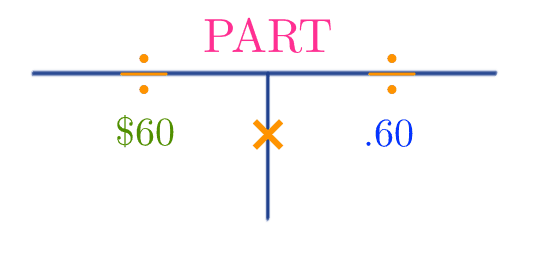
\( $60 \times .60 = $36 \)
Using the 30-day method, the seller will receive a credit, and the buyer will receive a debit of $36.
Suppose the problem asked for a calculation in actual days instead of the 30-day method. August has 31 days, so the denominators would change, and the buyer would get one more day.
The seller used \( \frac{12}{31}=.39=39\% \) of the HOA dues for the month.
The buyer will use \( \frac{19}{31}=.61=61\% \) of the HOA dues for the month.
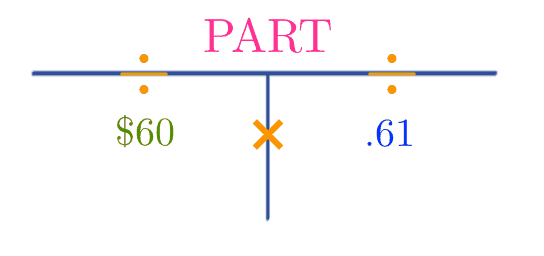
\( $60 \times .61 = $36.60 \)
Using actual days, the seller will receive a credit, and the buyer will receive a debit of $36.60.
Daily Proration (Single Month) Quiz
A buyer sold her house that closed on August 15th but had paid her $87 HOA dues at the start of the month. Calculate the proration using the 30-day method and explain in terms of debits and credits.
- The seller will receive a credit, and the buyer will receive a debit of $87
- The seller will receive a credit, and the buyer will receive a debit of $43.50
- The seller will receive a debit, and the buyer will receive a credit of $87
- The seller will receive a debit, and the buyer will receive a credit of $43.50
Click for the Answer and Explanation
Answer: The seller will receive a credit and the buyer will receive a debit of $43.50
Feedback: \( \frac{30-15}{30}=.50= \) \( 87 \times .50 = $43.50 \)
Daily Proration (Multiple Months)
Sammy Seller sold a house to Brenda Buyer. Sammy had already paid $2,700 in property taxes on January 1st for the whole year. The house closed on May 21st. Using the 30-day method, which one owes how much to the other? Explain in terms of credits and debits.
This problem combines monthly proration with daily proration. Since we're using the 30-day method, we first calculate the monthly and daily taxes.
To calculate the monthly taxes we divide the total by 12 months.
\( $2,700 \div 12 = $225 \)
To calculate the daily taxes, we divide the monthly taxes by 30.
\( $350 \div 30 = $7.50 \)
Since the buyer paid in advance, the seller owes a credit to the buyer.
We might be tempted to calculate the buyer's portion first, but when we're dealing with so many months and days it can help decrease the potential for simple mistakes to start with the buyer and then subtract.
The buyer owned the property for four full months (January through April) and one partial month (May). Since the closing day belongs to the buyer, there are 20 days in that partial month.
We calculate the taxes on the months by multiplying the number of months by the monthly taxes.
\( $225 \times 4 = $900 \)
We calculate the taxes on the days by multiplying the number of additional days by the daily taxes.
\( $7.50 \times 20 = $150 \)
Then, we get the total taxes that the buyer is responsible for by adding the two numbers.
\( $900+$150=$1,050 \)
But since the seller will get a credit from the buyer, we need to know what the buyer owes, so we subtract the seller's portion from the total taxes.
\( $2,700-$1,050=$1,650 \)
The seller will receive a credit, and the buyer will receive a debit for $1,650.
Let's look at the same problem with a few things changed.
Sammy Seller sold a house to Brenda Buyer. Property taxes of $2,701 are paid in arrears on December 31st. The house closed on May 21st. Using actual days, which one owes how much to the other? Explain in terms of credits and debits.
The first item that changed is that property taxes are paid in arrears (at the end of the year for the previous 12-month period). The second item that changed is that we're concerned with actual days and will not use the 30-day method.
I also changed the property tax number because it will give us a nice daily rate. Test writers will typically give you numbers that work out nicely, too.
Since Brenda will pay all of the taxes at the end of the year, Brenda will now receive the credit, and Sammy will receive a debit. That takes care of one of the changed items, but now we must calculate the actual days.
Actual days always use a 365-day year, so the first step is calculating the daily tax.
\( $2,701 \div 365=$7.40 \)
Then, we calculate the number of days that the seller owned the property by adding each month's days and the days the seller used the property in the partial month.
\( January+February+March+April+20 \)
Substituting the month names with the days in each month, we get the following:
\( 31+28+31+30+20=140 \)
The seller owns 140 days of the taxes, so let's multiply those days by the daily tax rate.
\( 140 \times $7.40 = $1,036 \)
The buyer will receive a debit and the seller a credit of $1,036.
Daily Proration (Multiple Months) Quiz
Sammy Seller sold a house to Brenda Buyer. Property taxes of $3,482.10 are paid in arrears on December 31st. The house closed on April 14th. Using actual days, which one owes how much to the other? Explain in terms of credits and debits.
- The buyer will receive a credit and the seller a debit of $992.16.
- The buyer will receive a debit and the seller a credit of $992.16.
- The buyer will receive a debit and the seller a credit of $982.62.
- The buyer will receive a credit and the seller a debit of $982.62.
Click for the Answer and Explanation
Answer: The buyer will receive a debit and the seller a credit of $982.62.
Explanation: Remember that the day of sale belongs to the buyer. Daily tax rate: \( $3,482.10 \div 365 = $9.54 \) Seller's used days: \( 31+28+31+13=103 \) Seller's share: \( $9.54 \times 103=$982.62 \)
Appreciation and Depreciation
Appreciation and depreciation are words to describe changes to the property's value.
Introduction to Appreciation and Depreciation
If a property’s value increases, that property has appreciated. Appreciation can be caused by several factors, including:
- inflation
- increasing demand
- property improvements
If a property’s value decreases, that property has depreciated. Depreciation can be caused by several factors, including:
- deterioration
- deflation
- decreasing demand
- external obsolescence: factors outside the control of the property like if a landfill or sewage treatment plant was built near the property)
Depreciation can also have to do with taxes on real estate investments. The government often allows real estate investors to deduct portions of the investment over time to reduce their total taxes.
Calculating Appreciation and Depreciation
A property was purchased for $500,000 and sold for $650,000 five years later. What was the property's total appreciation rate?
This is a simple T problem, but we first need to calculate the dollar amount that the property price is appreciated. The total in the T is the original purchase price.
\( $650,000-$500,000=$150,000 \)
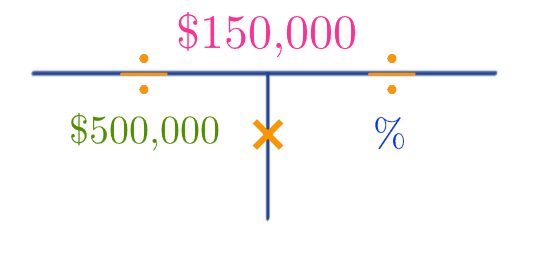
\( $150,000 \div $650,000 = .25 = 25\% \)
This property appreciated 25% during the time period.
That's the answer, but you might see a question asking for yearly appreciation instead of total appreciation. If that were the case, you'd simply divide the appreciation by the number of years.
\( .25 \div 5 = .05 =5\% \)
This property appreciated 5% per year.
Note that this style of problem can also be asked about depreciation.
A property was purchased for $300,000 and sold for $210,000 five years later. What was the property's depreciation rate per year?
\( $300,000-$210,000=$90,000 \)
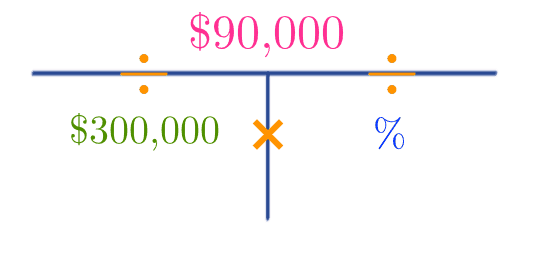
\( $90,000 \div $300,000 = .30 = 30\% \)
This property depreciated 30% over the five-year period, but the question wanted depreciation per year, so we have to divide 30% by the number of years.
\( .30 \div 5 = .06 =6\% \)
The property depreciated 6% per year.
A $172,000 property depreciates at 5% per year. How much is it worth after six years?
We'll solve this problem in three steps.
First, we'll calculate how much it appreciates in one year.
Next, we'll multiply that by six years to get the total depreciation.
We'll then deduct the total depreciation from $172,000 to get the property's value after six years.
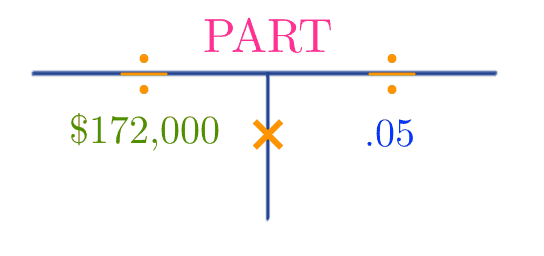
\( $172,000 \times .05 = $8,600 \)
\( $8,600 \times 6 = $51,600 \)
\( $172,000-$51,600=$120,400 \)
The value of this property after six years is $120,400.
You sold your house for $416,000, which was 30% more than the original purchase price. What was the original purchase price?
This one's a bit trickier. If you do a T calculation and use 30%, you'll be wrong.
Think about this closely. You have some unknown price.
You don't know what it is, but that price plus 30% more equals $416,000.
So 100% of that unknown price plus 30% equals $416,000.
Simplifying even more \( 100\%+30\%=130\% \) of the unknown price is $416,000.
So we use 130% in our T and $413,000 as our part.
You might find it odd that we're using what's going to end up being a larger number as the part, but that's because we're using a percentage greater than 100%, so the number on top will naturally be larger.
I know that I once told you almost always to put the smaller number on top when you're confused and don't know what to do.
That was meant to be a test-taking strategy for when you're absolutely confused because the smaller number goes on top in most exam questions.
That's even why I've been calling it the "part." But it isn't the case here, and we know what we're doing, so we'll put it on the top.
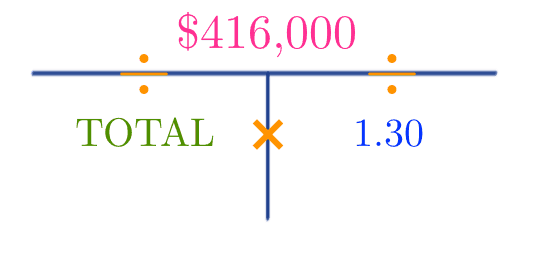
\( $416,000 \div 1.30 = $320,000 \)
You originally paid $320,000 for your house.
Calculating Appreciation and Depreciation Quiz
A property was purchased for $200,000 and sold for $350,000 five years later. What was the property’s total appreciation rate?
- 75%
- 25%
- 150%
- 15%
Click for the Answer and Explanation
Answer: 75%
Explanation: \( ($350,000-$200,000) \div $200,000=0.75=75 \% \)
A property was purchased for $500,000 and sold for $350,000 three years later. What was the property’s depreciation rate per year?
- 15%
- 5%
- 10%
- 30%
Click for the Answer and Explanation
Answer: 10%
Explanation: Total depreciation: \( ($500,000-$350,000) \div $500,000 = 0.30 = 30 \% \) Depreciation per year: \( 0.30 \div 3 =0.10=10 \% \)
A $500,000 property depreciates at 7% per year. How much is it worth after seven years?
- $255,000
- $35,000
- $245,000
- $465,000
Click for the Answer and Explanation
Answer: $255,000
Explanation: \( $500,000-($500,000 \times 0.07 \times 7)=$255,000 \)
You sold your house for $568,750, which was 25% more than the original purchase price. What was the original purchase price?
- $398,125
- $170,625
- $739,375
- $455,000
Click for the Answer and Explanation
Answer: $455,000
Explanation: \( $568,750 \div 1.25 = $455,000 \)
Depreciation for Taxes
You own an office building that is worth $650,000. The IRS allows you to depreciate the property over 27.5 years. How much can you deduct the first year on your income tax return?
To solve this all you do is divide the value of the asset by the number of years that you are allowed to depreciate it.
\( $650,000 \div 27.5=$23,636.36 \)
You can deduct $23,636.36 per year.
Remember that you can not deduct the value of the land. You might see a question where you have to remove the value of the land before you solve it.
You bought a rental property that is worth $200,000. The land is 15% of the total worth. The IRS allows you to depreciate the property for 27.5 years. How much can you deduct from the fifth year on your income tax return?
You might have noticed that I said the first year in the first problem and the fifth year in the second problem. The year actually doesn't matter because you're deducting over 27.5 years. Only that 28th year is tricky.
Before you divide by 27.5 you must calculate the value of the land and subtract it from the property's worth.
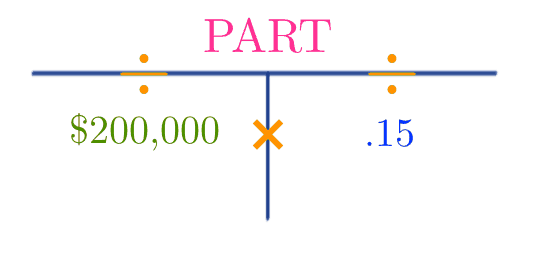
\( $200,000 \times .15 = $30,000 \)
\( $200,000-$30,000=$170,000 \)
We then solve just like we did in the previous example.
\( $170,000 \div 27.5=$6,181.82 \)
You can deduct $6,181.82 per year.
Depreciation for Taxes Quiz
You own an office building that is worth $229,000. The IRS allows you to depreciate the property over 27.5 years. How much can you deduct the first year on your income tax return?
- $8,327.27
- $8,481.48
- $8,178.57
- $8,807.69
Click for the Answer and Explanation
Answer: $8,327.27
Explanation: \( 229,000 \div 27.5 = $8,327.27 \)
Appraisal and Valuation
Any official appraisals are going to have to be done by licensed appraisers, but there are some types of appraising and valuation methods that you'll be expected to know on your real estate license exam.
Purpose of Appraisals
The purpose is to estimate the value of a property to determine the amount a lender will lend for the purchase of the appraised property.
Although the price that a buyer is willing to pay determines the value, lenders want to decrease their risk by not lending more than the property is likely worth based on whichever appraisal method is used.
For example, suppose there are ten properties identical in every way, all in the same neighborhood. Nine of them just sold for $100,000.
A buyer just put in an offer for $500,000 on the tenth identical property.
The value of the property is determined by what the buyer pays, but the lender is interested in what it’s likely to sell for should the buyer default on the loan. So the bank will likely only lend $100,000 based on the recent identical sales.
Cost Approach
The cost approach is best used when the property does not make any traditional revenue like retail sales or leasing income for occupants like churches or other non-profit organizations.
It is also the best approach to use for new buildings.
Instead of looking at revenue, the cost approach considers the value of the land, the value of replacing any improvements, and depreciation. It's based on the principle of substitution, which basically says that people would prefer to build something new if it's less expensive than something already built.
Simply put, the cost approach calculates the cost of building new minus any depreciation.
The usual formula is:
\( Value=(Construction \space Costs-Depreciation)+Land \space Value@ \)
But if you do get a question about the cost approach, you'll probably have to apply some of the other things you've learned. Test writers probably won't just tell you the depreciation amount as a dollar value. But we already learned how to calculate depreciation so we can easily solve problems like the one below.
What is the value of a 5-year old church that is 3,455 square feet and has a replacement cost of $45 per square foot, a depreciation rate of 3% a year, that's built on land that's worth $65,000?
The only item that's plainly given that we need to plug into the formula is the land value of $65,000. We have to do a bit more work to get to the other numbers.
To get the construction costs, we multiply the square feet by the construction cost (called "replacement cost" in the problem) of $45 per square foot.
\( 3,455 \times $45 = $155,475 \)
The construction (replacement) cost is $155,475.
To find the depreciation, we have to take off the stated depreciation rate 3% per year for five years since it is a five-year-old building.
We first find the annual depreciation by multiplying the construction cost by the depreciation rate. Hey, that's a T problem!
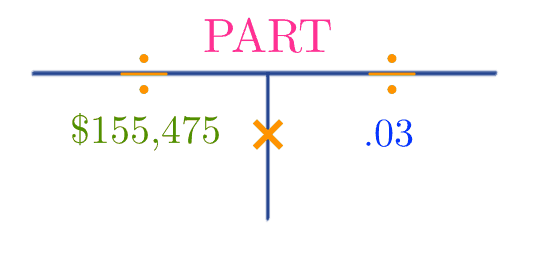
\( $155,475 \times .03 = $6,219 \)
The annual depreciation is $6,219. We multiply that by five because the building is five years old.
\( $6,219 \times 5 = $31,095 \)
The total depreciation is $31,095.
Next, we subtract the depreciation from the construction costs.
\( $155,475-$31,095 = $124,380 \)
The last step is to add the value of the land.
\( $124,380+$65,000 = $189,380 \)
The appraised value of the property using the cost approach is $189,380.
Cost Approach Quiz
What is the value of a 5-year old church that is 2,355 square feet and has a replacement cost of $35 per square foot, a depreciation rate of 3% a year, that’s built on land that’s worth $85,000?
- $89,121.25
- $155,061.25
- $164,952.25
- $70,061.25
Click for the Answer and Explanation
Answer: $155,061.25
Explanation: \( ($2,355 \times $35)-($2,355 \times $35 \times .03 \times 5)+$85,000=$155,061.25 \)
Sales Comparison (Market) Approach
The sales comparison approach is also known as the market approach.
A Competitive Market Analysis (CMA) is a method that brokers and salespersons use to help sellers price their properties when creating a listing. Although it's an appraisal method, it can't be called an appraisal when done by a broker or salesperson. Only licensed appraisers can conduct appraisals.
The techniques, however, are very similar in terms of what you need to know to pass your exam. The biggest gotcha on a question is calling it an appraisal when done by a real estate agent.
This approach compares the property of interest (the subject property) with others in the general area. The logic behind this type of valuation method is that a person would not likely pay more for a property than the selling price of recently sold properties that are similar and nearby. This is known as the principle of substitution.
The comparable properties in the general area are commonly called "comps."
Six nearby properties ("comps") are typically selected for this method, but it's not likely that there are six recently sold (or even listed) properties nearby that exactly match the subject property. They might differ in the lot size, number of bedrooms, number of bathrooms, or a variety of other features.
The sales comparison approach takes these differences into account when calculating the value. The value is adjusted based on the differences between the comps and the subject property. Possible differences include, but are not limited to:
- Lot size
- Square footage of the improvements (building/house)
- Terms of sale
- Architecture
- HVAC types
- Fireplaces
- Garages
- Outbuildings
- Swimming pools
- Quality of materials used
- Condition
- Age
- Location
- Date of sale
- Financing
- Number of bedrooms
- Number of bathrooms
A licensed appraiser is appraising a property. The subject property has three bedrooms, two bathrooms, and a pool. A comparable four-bedroom, two-bathroom property with no pool recently sold for $398,000. The appraiser finds that a bedroom is worth $7,000 and a pool is worth $12,000. If this was the only comparable in the area, what would the subject property appraise for?
The subject property has one fewer bedroom but has a pool. So that means we have to deduct the value of the bedroom and add the value of the pool from/to the selling price of the comparable.
\( $398,000-$7,000+$12,000=$403,000 \)
The property would appraise for $403,000.
Sales Comparison (Market) Approach Quiz
A licensed appraiser is appraising a property. The subject property has four bedrooms, two bathrooms, and a pool. A comparable four-bedroom, one-bathroom property that does not have a pool recently sold for $425,000. The appraiser finds that a bathroom is worth $6,000 and a pool is worth $15,000. If this was the only comparable in the area, what would the subject property appraise for?
- $446,000
- $434,000
- $416,000
- $404,000
Click for the Answer and Explanation
Answer: $446,000
Explanation: \( $425,000+$6,000+$15,000=$446,000 \)
Income Approach – Capitalization Method
The income approach calculates an appraisal value based on the property's income. The first method that you might be tested on is called the capitalization method.
To use this method, you need three numbers:
- Net Operating Income (NOI): This is the income after the deduction of certain expenses
- Rate of return, also called the Capitalization Rate (CAP Rate)
- Property value or sale price
Thinking in terms of the T method, the property value (sale price) is the whole, the rate of return is the percent, and the NOI is the part. These problems are actually very simple T problems.
A group of investors purchased a building that has a net operating income of $55,000 when the CAP rate is 9%. How much did they pay for the building?
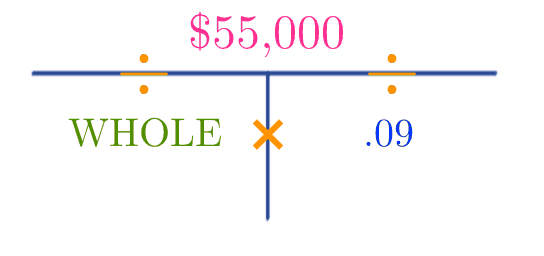
\( $55,000 \div .09 = $611,111.11 \)
The value of this building is $611,111.11.
You might see an exam question asking for the formula, but they won't use the easy T method. The good news is that you can turn any T-method problem into a formula by thinking about what goes where. In this case, the formula is:
\( Value = NOI \div CAP \space Rate \)
What is the capitalization rate of a building that recently sold for $855,000 with an income of $51,300?
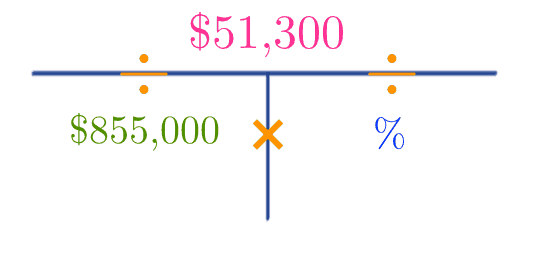
\( $51,300 \div $855,000 = .06 \)
The capitalization rate of this building is 6%.
What is the income of a building that you paid $425,000 to purchase with a capitalization rate of 4%?
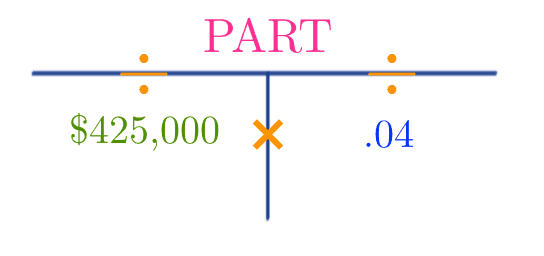
\( $425,000 \times .04 = $17,000 \)
The income of this building is $17,000.
Income Approach – Capitalization Method Quiz
What is the capitalization rate of a building that recently sold for $795,000 with an income of $55,650?
- 5%
- 6%
- 7%
- 8%
Click for the Answer and Explanation
Answer: 7%
Explanation: \( $55,650 \div $795,000=0.07=7 \% \)
Income Approach - Gross Rent and Income Multiplier Method
The gross rent and income multiplier methods calculate the value of a property based on either monthly (gross rent multiplier method) or annual (gross income multiplier method).
- Gross Rent Multiplier (GRM): Monthly Income
- Gross Income Multiplier (GIM): Annual Income
An office building has a gross monthly income of $7,500. Similar properties in the area are selling at a GRM of 140. What is the value of this commercial property?
It's super simple to solve this. We multiply the gross monthly income by the GRM.
\( $7,500 \times 140 = $1,050,000 \)
The value of this property is $1,050,000.
A property has a value of $810,000 and sells at a GRM of 120. What is the monthly income of this property?
To solve this, we do what we did for the last one, but in reverse.
\( $810,000 \div 120 = $6,750 \)
The GRM of this property is $6,750.
An office building that sold for $900,000 has an annual income of $60,000. What is the GIM of this building?
Now, we're looking at GIM, which concerns annual income. The problem gave the income number in terms of annual income, so we're actually ready to calculate exactly the same as above.
\( $900,000 \div $60,000 = 15 \)
This property has a GIM of 15.
An office building that sold for $840,000 has a monthly income of $4,375. What is the GIM of this building?
Here, we've been given the income as a monthly figure but need to calculate GIM, which is an annual figure. We can solve this exactly like the last one, with one additional step. We first have to convert the monthly income into annual income.
\( $4,375 \times 12=$52,500 \)
Now, we solve it by dividing the selling price by the annual income.
\( $840,000 \div $52,500 = 16 \)
This property has a GIM of 16.
Income Approach - Gross Rent and Income Multiplier Method Quiz
An office building has a gross monthly income of $9,800. Similar rental properties in the area are selling at a GRM of 180. What is the value of this property?
- $1,764,000
- $176.40
- $1,764
- $54.44
Click for the Answer and Explanation
Answer: $1,764,000
Explanation: \( $9,800 \times 180 =$1,764,000 \)
